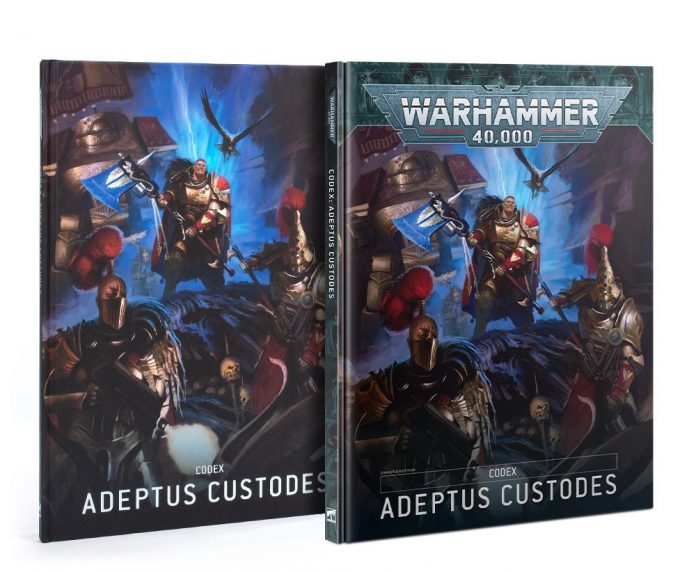How glorious do you like your heroic forces? Somewhat glorious? Very glorious? Extremely glorious? Do you prefer to rely on finely honed martial prowess and ornate weaponry rather than weight of numbers or primitive artillery? And do you want to play an army where you’re only going to need thirty models at the absolute maximum?
If any of that appeals to you then good news – the Adeptus Custodes 9th Edition Codex has arrived, ready to elevate these demigods of war to new heights of military might with a fully updated ruleset. Not only that, the forces of the Sisters of Silence are now fully integrated into this tome, allowing them to fight alongside the Custodes (or even form armies of their own) – perfect for if you like gold, but also like to have more than a dozen models in play.
For those of you eager to find out what this means for your army, or if you’re planning to start a new force for the new year, we have good news; Games Workshop have sent us a preview copy of this new book, and we’re ready to unseal the runic locks that hold fast the treasures within, all for your enjoyment. Many thanks to GW for providing us with the book, and let’s get into it.
Why Play Adeptus Custodes?
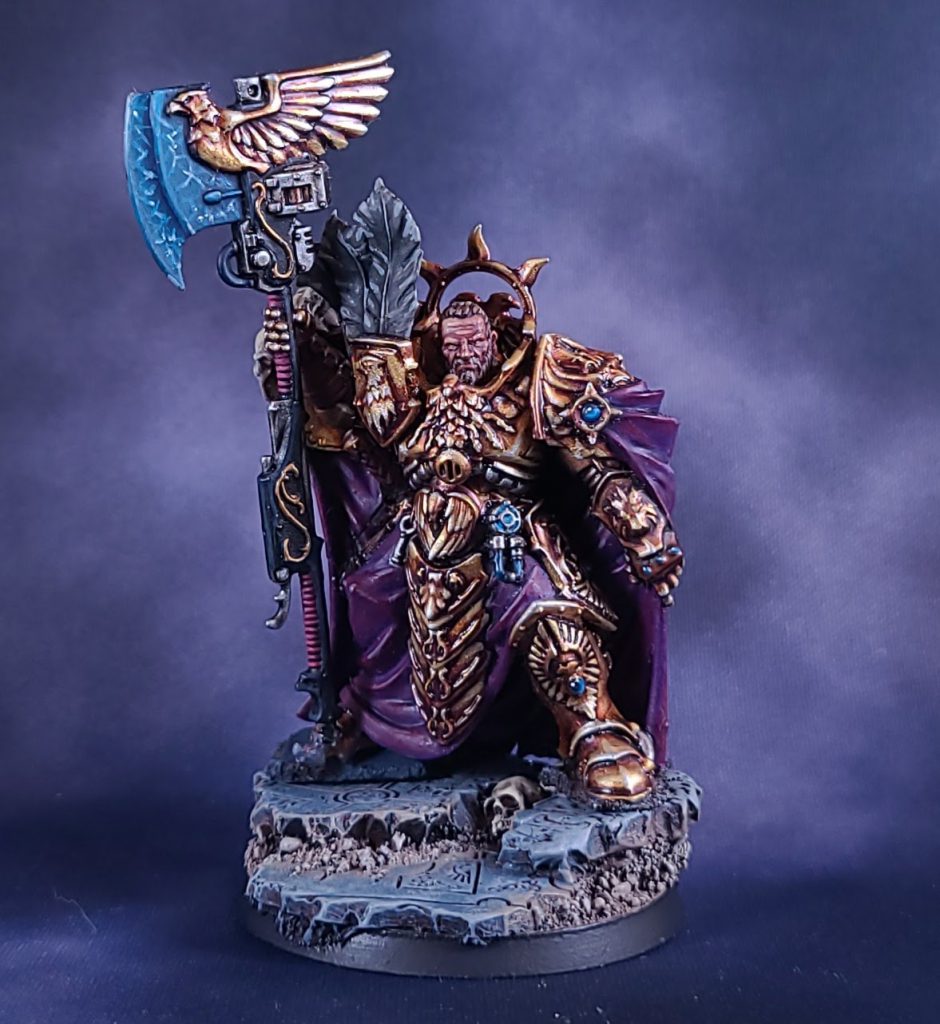
Custodes are the ultimate elite army. If you want to throw 25-30 models down on the table and have them go toe-to-toe with entire battalions of lesser combatants then this is the army for you. Custodes are an ideal painting project, with highly detailed individual models that you can really take your time on thanks to their small number, while in-game they’re hard as nails with every Custodian enjoying an impressive statline and the best equipment the Imperium has to offer.
What’s in this Book?
- Lore for the Adeptus Custodes and Sisters of Silence.
- Rules for building a force made up of either or both halves of the Talons of the Emperor.
- A new version of the Captain Commander rules, allowing you to upgrade your mightiest heroes into true conquerors.
- Crusade Rules, including rules for the Magisterium Lex Ultima – undertaking missions in the name of the will of the Emperor himself.
- All the Stratagems, Relics and Chapter Approved rules you’d expect from a 9th Edition book, including warlord traits and relics for the Knights Centura of the Sisters of Silence.
- Datasheets for all Adeptus Custodes and Sisters of Silence units.
The Five Best Things About This Book
- True Demigods: Stratagems, Shield Hosts and the Martial Ka’tah all come together to make each Custodian feel like a true god of war.
- Shield Hosts: Shield Hosts are massively powered up from their debut in War of the Spider, now acting as true subfactions and providing powerful detachment abilities in addition to Warlord Traits, Stratagems and Relics.
- Trajann: Trajann Valoris takes his rightful place as one of the most powerful all-round commanders in the business; we’ve taken to calling him the Dreadnought who walks like a man.
- Martial Ka’tah: The Ka’tah rules feel like they hit a real sweet spot, with enough depth, power and ability support to help adapt your forces to whatever foe they’re facing.
- Continuity: From our early testing, all the stuff that’s already great in Custodes stays strong, including Forge World favourites like Venatari and the special Contemptors, while weaker options get smartened up in a way that should make the range deeper and more rewarding no matter what kind of golden demi-god you prefer.
Where’s Crusade?
As always, our Crusade experts will be taking a look at the Narrative rules for the Adeptus Custodes on Tuesday, so if that’s your favourite game mode make sure to check back in then.
A Note on Forge World
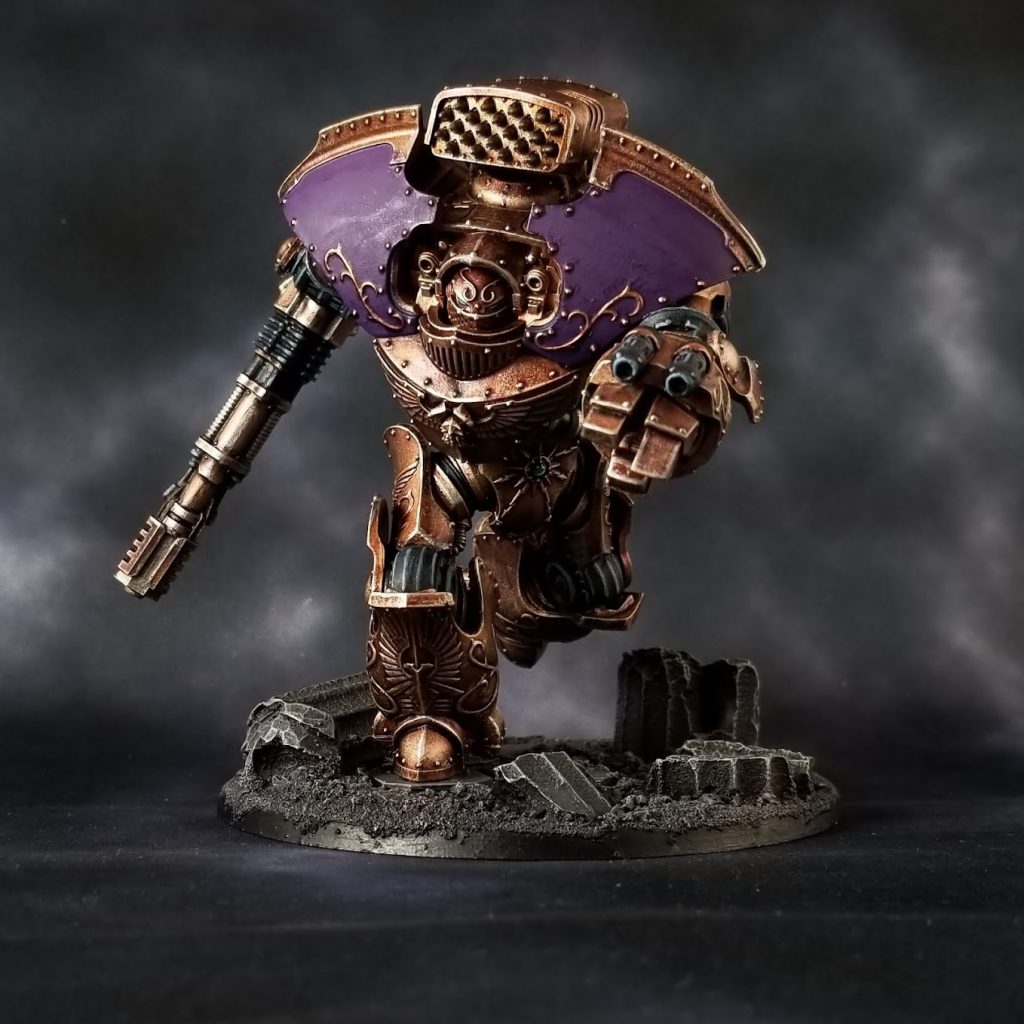
The Adeptus Custodes have an unusually broad range of viable Forge World units, many of which have featured in their very best builds throughout 8th and 9th edition. We’ll be talking about these throughout the review, since to both us and the majority of players they feel like a core part of the range. The datasheets in the Imperial Armour Compendium are mostly in line with 9th edition expectations, e.g. including the CORE keyword where it’s warranted, but there’s one or two bits missing from these where we’re expecting a quick errata to bring them up to date. Notably, we have assumed that Martial Ka’tah is going to be added to all INFANTRY and BIKER units. The Codex also introduces a new weapon type called Auric Weapons, which covers all flavours of “blade but also a gun”. While there are some weapons like this in the Compendium, we have not assumed that any will get this tag, as the wording in the Codex is pretty specific. If that gets added, it will be a pleasant surprise for a few units.
The Rules
Detachment Abilities
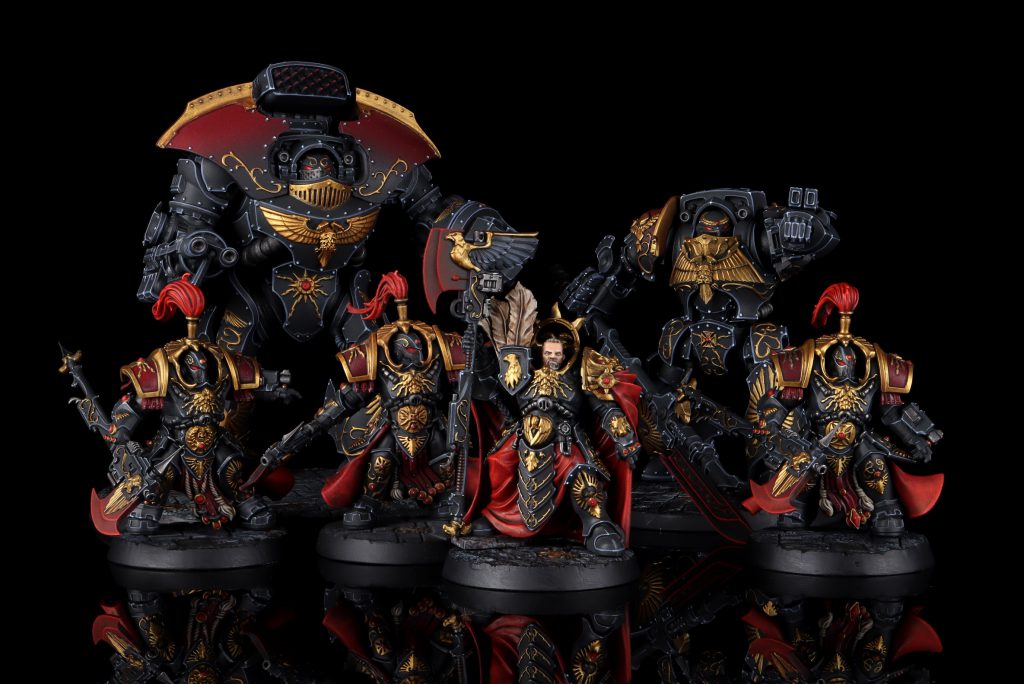
The Adeptus Custodes get some pretty hefty detachment rules right out of the gate. As with all armies, this section starts by defining what an Adeptus Custodes detachment is. In this case, as well as allowing you to bring ADEPTUS CUSTODES units (and the expected Agents of the Imperium and Unaligned stuff) you can also include ANATHEMA PSYKANA (Sisters of Silence) units, as long as you comply with the Emperor’s Legion rule. This aims to ensure that the Custodes themselves still form a key part of your forces, and means you cannot have more Sisters of Silence HQs than Adeptus Custodes HQs or more SoS Troops than Custodes Troops, and you also cannot select a Sisters of Silence model as your warlord. In addition to this, and in common with a lot of armies, you have limits on duplicating Captains – each of the three flavours of Shield Captain can only be taken once per detachment (this should almost never be a problem).
Note: Before anyone tries to gotcha us in the comments – yes we have noticed that Sisters and Custodes units don’t share a Faction Keyword other than IMPERIUM for Battle Forging, but we expect a very swift FAQ to the GT Mission Pack army construction rules to allow this – and that’s assuming it isn’t already covered in Warzone: Nachmund. This rule makes it abundantly clear that you’re meant to be able to take them together in a detachment.
When you build an Adeptus Custodes detachment you get a whole host of benefits. First up, all Adeptus Custodes INFANTRY models gain ObSec, as well as Sisters of Silence Troops (i.e. Prosecutors). This means you get much broader ObSec than in other armies, most significantly with all your footslogging characters having it too, though in this edition it no longer applies to BIKERS (but they still have plenty of appeal, as we’ll see).
The objective power doesn’t stop there either – new for the 9th Edition book, all Adeptus Custodes models (including Dreadnoughts and Bikers this time) count as one additional model for the purposes of controlling an objective, which means your three model units now outnumber five-model utility squads from other armies. We’re also wondering if there might be something in Warzone: Nachmund so that they count as extra models for objectives like Retrieve Nachmund Data and Engage on All Fronts (or, in fact, just a generic rule that applies to all units that count as extra models), as without that Custodes do end up struggling a bit on Action secondaries – though this is a good place for the Sisters of Silence to fill in.
Being Extra Big provides a further benefit too – Custodes also now count as an extra model when providing Look Out Sir to friendly characters from the same Shield Host, meaning that it’s much harder for opponents to pick off one model from multiple units then start sniping your characters (though Knight Centuras need to be careful, as they don’t belong to a Shield Host and so don’t get the extra protection).
Speaking of Shield Hosts, these are now full-fledged subfactions like in other books. As long as every model in your detachment that has the <SHIELD HOST> keyword has the same one, they gain a Shield Host Fighting Style (i.e. a faction trait) and unlock an extra relic, Warlord trait, and Stratagem.
As well as an Adeptus Custodes detachment, you can also build a pure Anathema Psykana Detachment. This doesn’t really provide anything special, but it does allow you to run a pure Sisters of Silence army if you want to, without the Emperor’s Legion restrictions discussed above. As a neat touch, you can bring Valerian along in one of these and still qualify.
Army-wide Rules
Martial Ka’tah
The marquee new rule for the Custodes in this iteration is Martial Ka’tah, which is their new mono-faction bonus (though like similar rules, and like for Detachments above, you can slot in the usual suspects of UNALIGNED/AGENTS OF THE IMPERIUM as well as ANATHEMA PSYKANA without breaking it). As well as being pure Custodes, your whole army has to be from the same Shield Host to activate this.
This is a datasheet ability that is present on all INFANTRY and BIKER Custodes units, and works like a sort of hybrid of Marine Doctrines and Necron Command Protocols. A Ka’tah is a fighting style the Custodes have developed for specific situations, and there are six detailed in the book. Each Ka’tah has two different Stances, each of which provides a bonus to all relevant units, and over the course of the game you can activate up to five Stances for one turn each.
To determine what Stances you get to use, after deployment (but before the first turn roll-off) you select three Ka’tahs and designate each as your Primary, Secondary and Tertiary for this game. In your first Command Phase, you must then choose one stance from your Primary Ka’tah to activate, and this lasts till your next Command Phase. In the second Command Phase, you can either select the other Stance of your Primary Ka’tah, or one from your Secondary. Once you have activated a Secondary Ka’tah stance, you are free to move on to your Tertiary Stance in a future turn – but you cannot ever move “backwards”, and cannot use a Stance more than once. That means that if you choose to go straight to Secondary on turn 2 and onward to Tertiary on turn 3 you can run out of Stances on the final turn (though a Warlord Trait can rescue you here), but otherwise you’ll go through five.
This ends up pretty wordy on paper, but we think people will get used to it very quickly – the easy shorthand for how it works is that it’s Combat Doctrines, you can stay in each for up to two turns before moving on, but if you do stay in one for two turns it has a different effect on each.
Like Combat Doctrines there are also some effects that can manipulate this – each Shield Host has a favoured Ka’tah, and get to use both stances at once for one of the turns they’re in it, you can re-order your Stances on the fly with a Warlord trait, and a few abilities allow a unit to adopt a different Stance to the rest of the army, notably the Martial Discretion stratagem, which lets a single unit adopt any Stance for a turn (even one that’s not from a Ka’tah you’ve picked as one of your three).
That’s how you activate them – what do they do?
Calistus is for going fast, allowing your models to either roll an extra dice and drop the lowest when Advancing, or to count as stationary for shooting purposes after a Normal Move or Advance. Both are good ways to open the game, and this one will be seen as the Primary Ka’tah a lot. In particular, being able to zoom Vertus Praetors 20” and still fire salvo launchers makes it hard for the opponent’s tanks to hide.
Conservai is likely to be one of the least picked Ka’tahs, but very potent to reach for with Martial Discretion, as it allows units to either Fall Back/Advance and still perform an Action, or Shoot while doing so without it failing. You don’t generally need this army wide, but on one unit it’s exceptionally useful.
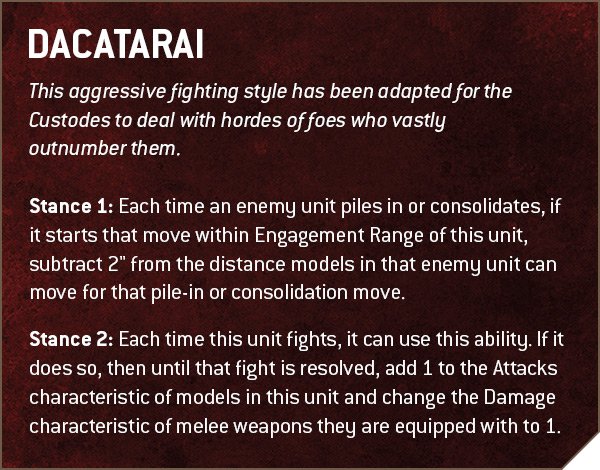
Dacatarai is going to be a mid-game workhorse. In theory it’s a specialist anti-horde melee trick, but in the current metagame it’s good against almost everything. Both effects here are strong, one cutting the enemy’s pile-ins/consolidations down by 2” as long as they’re in Engagement Range, and the other letting you optionally drop your units’ damage down to 1 to gain an extra attack. The latter obviously is good against hordes, but it’s also excellent against units with Damage Reduction, which are a real bane for an army that’s mostly sporting D2 weaponry. Stopping units like Dreadknights and Talos use their large bases for positioning during pile-ins is also great, and this stance is going to be vital for attacking the metagame as it stands.
Salvus is for shooting, and it’s got two neat tricks – extending the range of guns by 4” or allowing double shooting with Auric weapons. Custodes don’t put down huge volumes of Auric stuff, but this is another one where reaching for one of these out of cycle can squeeze some extra value out of a unit that’s not otherwise contributing for a turn, particularly praesidium shield Guard, who are quite short ranged. Note that this one gets spectacularly better if any of the Forge World guns get the Auric tag added.
Rendax is for those hunting the biggest and most dangerous game (namely MONSTERS and VEHICLES), granting either auto-wounds on 6s to hit against them (both at range and in melee) or +1S in the first round of combat. The auto-wounds is the big prize here, as it effectively doubles the chip damage capabilities of the army at range if it finds itself up against T8 targets, and still provides a considerable boost against medium weight targets (though if they have Damage Reduction, Dacatarai can be better).
Finally, Kaptaris is designed to force opponents to conduct honourable duels, whether they like it or not, either turning off their melee hit re-rolls or forcing them to roll off before being allowed to fall back. This is great for putting a boot on the opponent’s neck in the mid-late game if you’ve got good momentum, providing the army with the staying power to last the rest of the game, and it should be a popular Tertiary choice.
This is great stuff overall, especially with the ease with which you can access these effects in an emergency with Martial Discretion, and help really juice up the non-Dreadnought units of the army (clearly a goal of the book). As a starter for ten, lining up Calistus, Dacatarai/Rendax (target depending) then Kaptaris provides you with a suite of tricks perfectly aligned to the Custodes game plan – the boosted advances get you to the mid board, the damage dealing mid-game option takes a chunk out of the enemy, then Kaptaris shuts down any desperate final plans they have and secures victory. GIven that this is probably as close to a “default” setup, the two Shield Hosts that specialise in Dacatarai and Rendax get some extra value from this ability, as it means those crucial mid-game turns will be extra potent. That’s our initial stance on this, and we’re excited to see how players use this in the wild.
Aegis of the Emperor
Also appearing on all INFANTRY and BIKER units, Aegis of the Emperor provides Custodes with their signature defences – a 4+ invulnerable save, and a 6+ chance to resist Mortal Wounds. The latter has even been improved from 8th Edition – it’s now all Mortal Wounds, not just those in the Psychic Phase. No great surprises here – this is a foundational part of how the army works.
Daughters of the Abyss
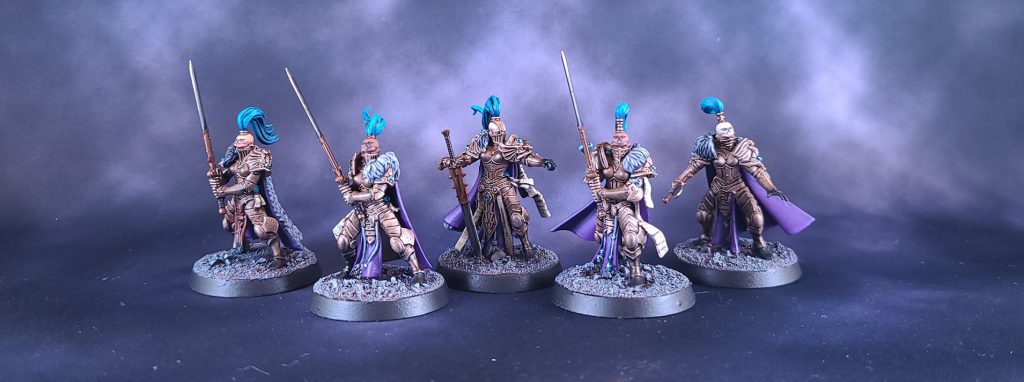
The Sisters of Silence get their own signature ability here, representing their status as Psychic Nulls. They cannot be affected or targeted by Psychic Powers, and each unit that is within 18” of enemy Psykers when they try and Manifest applies -1 to the roll, stacking up to three times. Finally, if they attack a Daemon or Psyker they get +1 to wound. We expect to see a Knight Centura snuck into quite a few lists because of an extremely potent Warlord trait she can have, plus experimentation with Prosecutors to add cheap Troops, so this becomes a handy marginal bonus against some armies for forces that make these choices.
From Golden Light
Your bog standard Deep Strike ability, given a fancy name for ease of use on Stratagems etc. (which we fully endorse).
Auric Weapons
Last up, some of the Custodes weaponry get a new tag that mostly covers compatibility with the Salvus Ka’tah. Auric weapons include sentinel blades, guardian spears, castellan axes and any relics that replace them, plus the two specifically named examples that appear on datasheets.
Subfactions – Shield Hosts
Like most armies, the Adeptus Custodes are not a uniform force, and have different groups within them that practice different styles of warfare. These are the Shield Hosts, and these have been substantially levelled up from their first appearance in War of the Spider. These are now “true” subfactions, with each giving the forces within them a two-part detachment ability (a “Shield Host Fighting Style”, specialisation in one of the Martial Ka’tahs, and a Warlord Trait/Stratagem/Relic as you’d expect. Like most subfactions in 9th, in order to use the Relic you need to have a model from the relevant Shield Host as your Warlord, but given that Custodes lists are heavily encouraged to stick to a single host by Ka’tahs, that probably won’t be an obstacle very often – especially as Trajann now gets the SHIELD HOST tag!
Five Shield Hosts were introduced in 8th Edition, and this time around they’re joined by a “none of the above” option in the Emperor’s Chosen, effectively just a sixth host whose rules apply if you come up with your own fluff and name. This is presented first in the book, but we’re going to push it to last in the review for reasons that we’ll get to.
Shadowkeepers

Credit: Pendulin
The Shadowkeepers hunt down terrible beings and relics and consign them to the Dark Cells, and are equipped to duel the most nefarious beings in all the galaxy as a result. Their Fighting Style reflects this – any enemy within Engagement Range of them gets -1A, and they get full wound re-rolls against CHARACTERs, allowing them to soak up assaults from waves of minions and making them preposterously dangerous to monstrous CHARACTERs like Hive Tyrants, Daemon Primarchs and Dreadknight Grand Masters. Uh. Those last ones have probably gone rogue or something. They also specialise in the Kaptaris combat style, allowing them to trap their weakened foes in a deadly melee for multiple consecutive turns if needed.
Helping with the general angle of striding into battle with terrifying foes are the Warlord Trait and Relic, which can combine to create a truly terrifying character killer. The Lockwarden trait lets you straight up ignore invulnerable saves when attacking a Character, while the Stasis Oubliette is a single-target Fight Last – always welcome, and great in combination on a Bike Captain you’ve upgraded with Tip of the Spear.
People who’ve played Custodes prior to this book will, of course, be mostly here to see what’s become of the Stratagem. Grim Responsibility still subtracts -1S from incoming attacks, but it’s been hit with a very important change – it can no longer be used on Vehicles, so it’s not as good for creating indestructible Telemons. It still has a powerful niche on protecting Vertus Praetors, as it’s very good in combination with The Emperor’s Auspice (which is now only 1CP for smaller units).
All together – still a great Shield Host, but tuned more towards herohammer and supporting three-model Bike Squads rather than Dreadnoughts.
Dread Host
The Dread Host terrorize anyone who dares chafe against the Imperium’s yoke, teleporting into battle and sowing utter devastation. Their Fighting Style favours close-ranged warfare, providing Charge re-rolls and improved AP when attacking enemies within 9”. That makes castellan axes especially strong in this Shield Host, as bringing these up to ap-3 mitigates their only real weakness. It also makes a close-ranged volley before closing to battle that much more effective, and is somewhat interesting with hurricane bolters on the bikes (though salvo launchers are so juicy that this might not actually prove to matter). Also very important for the Dread Host is that Dacatarai is their favoured Ka’tah, and it’s plausible that the +1A option here is the best Stance to have the option on doubling up on. Finally, before we leave the trait, it’s worth highlighting that there’s some excellent joined-up rules writing around the Charge re-roll – everything else in this book that provides Charge re-rolls is written so that if the unit could already re-roll, it gets +1” instead – so 8” re-rolling Eternal Penitent charges are go.
Improving charges used to be what the Dread Host’s stratagem did, but now that this is built into the trait the Golden Light Of the Moiraides has a new trick, which is providing a unit that teleports in -1 to hit against it till your next turn, plus preventing Overwatch. This is maybe a little steeply priced at 2CP, but Custodes are definitely angling to throw threats at the enemy that they just can’t stop, and this certainly contributes.
More exciting is the new version of All-Seeing Annihilator, the Dread Host’s Warlord Trait. This lets you choose a CORE unit within 6” in your Command Phase, and gives them exploding 6s on hit rolls. At first glance this may look weaker, as it used to be an aura, but it also used to be melee only, whereas now you can drop this on a big unit of Sagittarum or Venatari and go wild with their shooting. Double-exploding kinetic destroyers anyone? Finally, their relic is the Adonimortis, a super-powered castellan axe that hits like a truck. This has the mild issue that a lot of relics intended for Allarus Captains have of not being the Praetorian Plate (hoo boy, we’ll get to that one) but it’s pretty cool, and fine to throw out on a regular Shield Captain or even a Vexillus Praetor.
The Dread Host can combine their tools to lash out with some nasty teleporting threats while a firebase built around a buffed unit do some wicked work, and provide especially strong support for Venatari – their shooting is good with All-Seeing, and their melee weapons are already D1, so Dacatari is a strait buff
Aquilan Shield
The Aquilan Shield impose themselves as bodyguards upon unsuspecting Imperial VIPs, and their abilities turn them into resolute defenders. All their CORE units can perform heroic interventions as if they were Characters, and they ignore the AP on attacks with AP-1 – certainly not bad on a faction that’s nearly all on 2+ saves. Their Ka’tah specialisation is Salvus, which is a bit less exciting, as you generally don’t need it on lots of units, but can be decent to give reach to units with sentinel blades who are otherwise stuck shooting at 12” range.
Shields are a general theme here, as their relic is the Praesidius, adding -1 to wound on the character, and letting you create a supreme tank in combination with Revered Companion, which halves incoming damage (also monstrous on a Bike Captain, especially as you can stack Superior Creation as well).
Their Stratagem is one of the most unusual in the book, and works both within it and in soup. It allows you to turn all your Aquilan Shield CORE units into Bodyguards for a designated Imperium INFANTRY Character, preventing them being shot as long as there’s an Aquilan Shield character within 6”. Given the disincentives on soup in this book there aren’t that many obvious uses of this, but one thing you can do is brutally ruin the day of the Thousand Sons by running a Knight Centura out in front of your army and having her just stand there flipping people off and eating Smites.
The main appeal here is definitely the Warlord Trait – a Bike Captain built with it is the toughest thing you can create in the whole book. That may not quite be enough to get this host into competitive builds, but it’s certainly very funny – and if a few Forge World options do end up getting the Auric tag on their guns then double Salvus suddenly looks far spicier.
Solar Watch
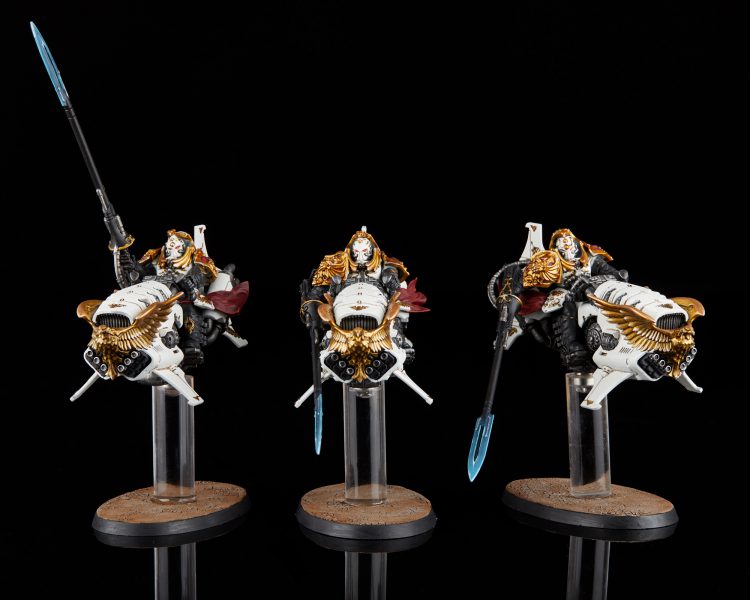
The Solar Watch restlessly patrol the space around Terra, and they are the Shield Host for going fast, specialising in the Calistus Ka’tah, adding 1” to their Advances and Charges, and being able to Fall Back and Charge. Their Warlord Trait further leans into this, letting one INFANTRY unit within 6” of the Warlord Charge after Advancing, which can be powerful when combined with the Swift as the Eagle Captain-Commander upgrade, allowing a Captain to get in on the action here too.
The relic is also on a mobility kick, an upgraded Guardian Spear that lets the bearer shoot after falling back, but this honestly doesn’t feel like it’s quite enough to be worth a slot. The stratagem is also kind of whatever – after slaying the enemy Warlord you can give the enemy a permanent debuff to Combat Attrition, which is super situational.
Despite being ambivalent on some of what’s here, the core mobility tools are good enough that this is probably one of the Hosts with the highest chance of seeing serious play. The new book really encourages you to try out lists which go heavy on Custodians of various flavours, and the mobility on the table that the Solar Watch can inject into that plan is pretty unique.
Emissaries Imperatus
The Emissaries Imperatus bring the word of the Emperor to the galaxy, or in more recent times hosts of augmented Space Marines ready to join recalcitrant Chapters. They are unstoppable when they set their minds to a goal, represented by them Fighting First at all times, and being able to ignore hit and wound roll modifiers. That makes facing these a stark challenge for melee armies in particular, as they’re going to take swings at you every time a fight breaks out, and can bypass some flavours of defences. If they’re on an Action plan then their Conservai Ka’tah also ensures they can always reach their goal, though as mentioned when talking about Ka’tahs, this isn’t one you’re super motivated to double up on.
Their Ka’tah might be a little niche, but their Stratagem Into the Darkness is a good one. This lets a CORE unit make a pre-game Normal Move at the start of the first Battle Round, and while it isn’t cheap (2 or 3 CP depending on unit size) you may well be willing to pay quite a lot to reliably shove a big unit of Vertus Praetors or Venatari into the opponent’s face right out of the gate (or hide them if you lose the roll off). The Warlord Trait is also decent when applied to a Vexillus Praetor, as it boosts aura radii, and a wall of Custodians with Light Cover against shooting and Fight First in melee is pretty daunting. The relic isn’t up to much, but as with pretty much all the Shield Hosts there are definitely some cool things you can do here. However, what if instead you just took…
The Emperor’s Chosen
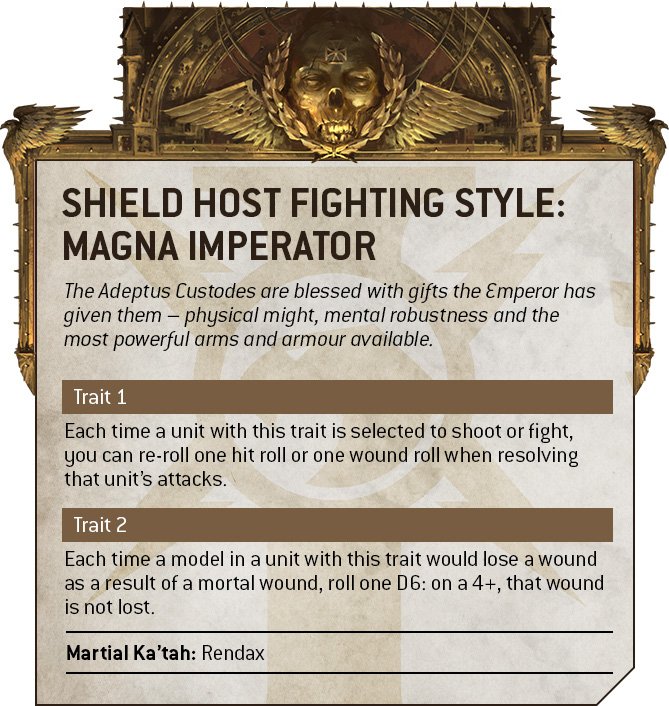
The Emperor’s Chosen might be the newest option on the block, but boy have they come out swinging. Their Fighting Style is a truly spectacular all-round trait, providing the industry-standard one re-roll of a hit or wound each time the unit shoots or fights, and the ability to ignore incoming Mortal Wounds on a mighty 4+ rather than the normal 6+. This is, bluntly, one of the best faction traits in the entire game. Single re-roll traits are at their best on powerful, accurate units, as they let you smooth out the inevitable occasional roll of a one, and have a very high chance of “converting” that re-roll into a success. Meanwhile, essentially extending the Custodes’ 4+ invulnerable save to mortals as well is absolutely brutal, bringing various angles of attack against them crashing down to earth. This stuff is great on everything, but also unusually strong on some of the Forge World dreadnoughts and tanks, with Pallas Grav-attacks looking uniquely great as an option for sponging up mortals against psychic forces and landing reliable hits with the trait. The Chosen also specialise in Rendax, which isn’t always what you want but is extremely good to double tap with in matchups where it’s relevant.
If having that powerful trait isn’t enough for you, why not change it? The Chosen’s stratagem lets a unit adopt a different Host’s fighting style for a turn for a mere 1CP, which can be phenomenal with the Shadowkeepers, Solar Watch or Emissaries when the situation demands it. The Warlord trait is also pretty good, allowing the Warlord to make extra attacks each time they fight, one per model destroyed to a maximum of four. With the statline of their melee weapons and options to utilise Dacatari for additional swings, this is great for flattening hordes and elite infantry alike.
Their relic is a fairly innocuous upgraded guardian spear but it fully doesn’t matter – the Fighting Style here is so exceptional and so consistently great that the Chosen essentially have first dibs on any list you’re building, and you need a very compelling reason to leave them on the shelf. As we’ve seen, there are some very cool things other Hosts can do, so it’s possible builds using them emerge (with the Solar Watch probably the most likely culprits) but if you don’t have that kind of tailored plan then it’s very likely that the generalist power of the Emperor’s Chosen is going to be your go-to pick. In addition, if you’re planning on souping Custodes Dreadnoughts with other Imperium armies then please start re-branding them from Shadowkeepers to Emperor’s Chosen forthwith – this trait is incredible on them.
Stratagems
One of the big strengths Custodes have always had is the power of their defensive stratagems, and the new book doesn’t disappoint. A general trend across the Stratagem sheet is varying costs for small units (3 or fewer models for some, 4 or fewer for others), and this means that if you go wide with small units you get some exceptional value in here.
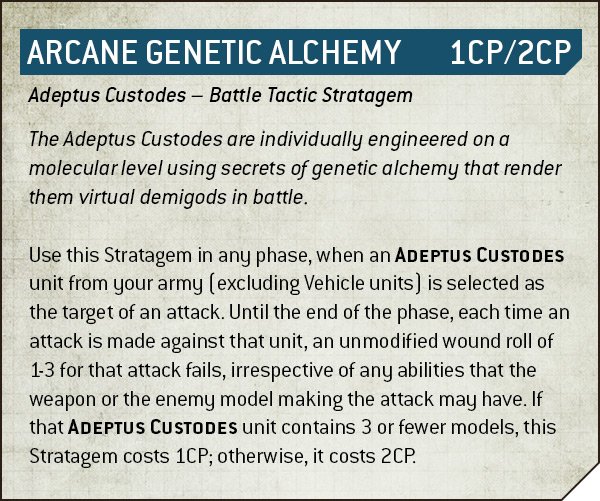
Both Arcane Genetic Alchemy (cannot be wounded on anything less than an unmodified 4+) and The Emperor’s Auspice (no re-rolls for incoming attacks) return in this new mode, and let me tell you that from some test games we’ve played, trying to take down a Vertus Praetor unit that can pop these for 1CP each is brutal. Auspice is particularly notable, as the lower 1CP cost applies to single-model units like Vehicles too and it now stops the opponent re-rolling damage as well. These have always been your bread and butter, but the extent to which you can just slam both of them for several consecutive phases when necessary is new, and incredibly powerful. Slayers of Nightmares to boost wound rolls against big targets and Martial Discretion for Stance-swapping are also in this club, and a further incentive to build lists with lots of small units. At the other end, one of the few things that rewards bigger units is the new Rapid Reactions stratagem, letting an INFANTRY unit shoot an enemy after they fall back. This is especially nasty on Venatari, who hit the sweet spot of having good shooting, often being used in 5s, and being fast enough to tangle with the enemy.
Other returning favourites take some mild nerfs to compensate, though nothing too extreme. Tanglefoot Grenade returns to tank your opponent’s movement/charges, but can now only be used once a turn, so you can’t just straight up freeze some poor soul for an entire turn with good rolls. The Eternal Penitent upgrade for dreadnoughts, giving an extra attack and charge re-rolls, also gets a cap, now only being usable once. Finally, Indomitable Guardians, a 1CP Fight interrupt you can use if you’re near an objective, does at least now need you to be eligible to fight. There are also a few popular tools that are just straight up gone too – most notably, pour one out for Stooping Dive (though at least Ruleshammer will never have to think about it again). The blow of that one is mitigated a bit by another upgrade – Fraternity of Heroes is back to give you the option to heroic with any unit, but now also boosts heroics out to 6” for any model that could already do so (e.g. Characters, Aquilan Shield units). Elsewhere in losses, the old version of Vexilla Teleport Homer that let you pull a close-in deep strike is also essentially removed, now just letting a Terminator unit snap back to a banner, but needing to be outside 9” of the enemy. Rapidly repositioning a powerful unit is still good, but you can’t wreck unprepared opponents with it any more.
For going on the offence, you’ve got a couple of improved force multiplication options. Dreadnoughts get the 9th edition version of Wisdom of the Ancients, now called Wisdom of the Moritoi, providing one of two auras to re-roll 1s for either hit or wound rolls, and this is especially strong in a faction that only has one model who can bring the latter naturally. This lets you use a Dreadnought to anchor a flank, making the army a bit less reliant on clustering up in a big mass around Trajann, and is a really good addition. Avenge the Fallen is also much better – this gives you +1 Attack if your unit is below its Starting Strength, or a mighty +2 Attacks if they’re below half strength, and is a steal at 1CP (and no longer requires the deaths to have happened that turn). This can make an opponent swinging and missing at a Custodian unit absolutely brutal, most especially if they go into a five-model squad and kill exactly three. The way this scales ensures that anything less than a full unit kill will often risk the attacker getting wiped in response, and it’s going to see far more usage now.
There’s also some tools for the Sisters of Silence, getting the expected ability to negate a psychic power on a 4+ (re-worded now to close off tedious arguments about whether you need to attempt to Deny the Witch first – you don’t), and also some offensive strats, the most notable of which is Purgation Sweep to boost the strength of witchseeker flamers up to 5. This is nice in combination with them gaining AP-1, as it ensures they can chip away at almost anything.
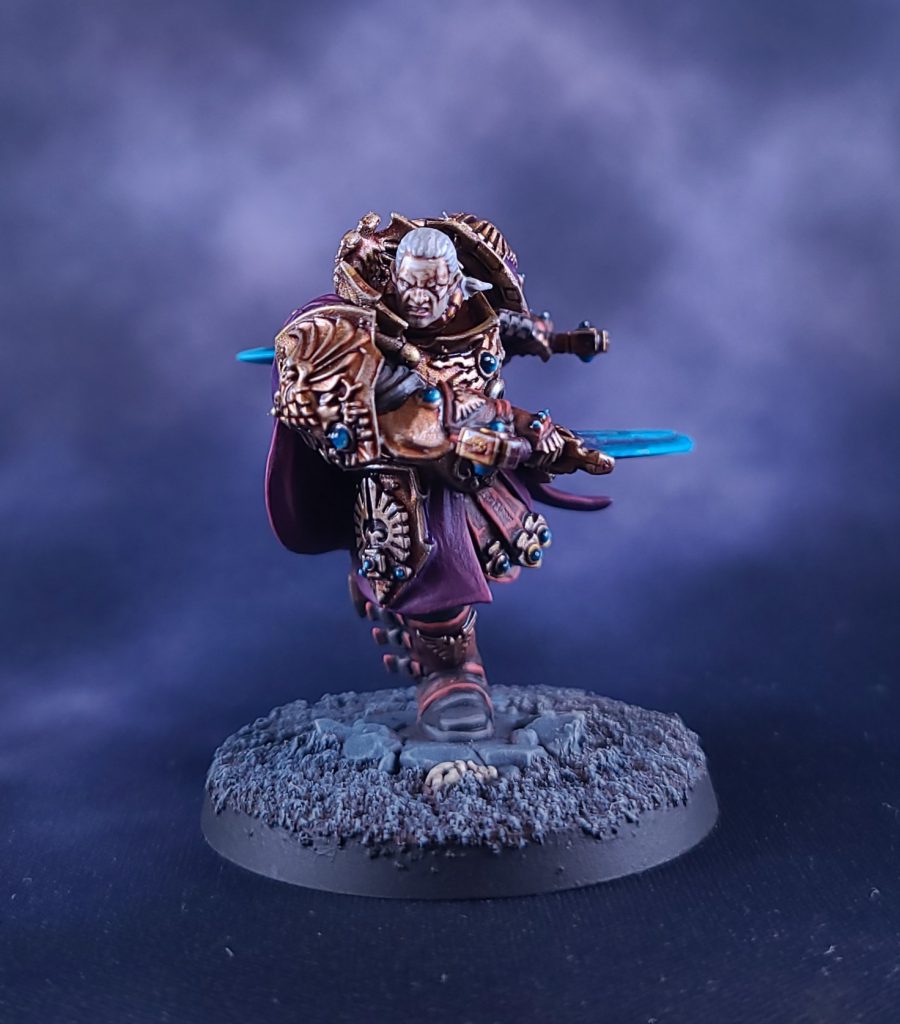
Finally, the standard extra Warlord Trait and Relic options (The Emperor’s Heroes and Open the Vaults, in this book) are here, plus a few more Character upgrades. Instead of its old effect Victor of the Blood Games now lets you give a model a second Warlord Trait, and importantly you can do this on a model that gained a Warlord trait from The Emperor’s Heroes, unlike the Space Marine which only allows you to add a second trait to your actual Warlord. This is great, because Trajann now has to be your Warlord if you take him, so having this option means you can still create your own monstrous hero to fight alongside him. Lastly you have the very unique Earning of a Name, letting a non-Named Character who slays an enemy Character in melee take a permanent upgrade for the rest of the game. This can either be one half of any of the Shield Host Fighting Styles, or permanently benefitting from a Ka’tah stance of your choice. There’s some mean stuff you can do with this – picking up the Shadowkeeper -1A ability can make your champion a real pain, as can adding the Fall Back prevention of Rendax. It’s super cool, super flavourful, and a great way to round out the Stratagems section.
Overall this is a great freshening up of the Custodes’ Stratagem suite; the janky 8th edition stuff you could do has been safely sealed in the Black Cells where no-one will miss it, but your tradeoff is having better access to a number of powerful mainline defensive Stratagems at a cheap cost. Stratagem sections live or die by how they enhance the flavour and capabilities of your army on the table, and this one is a success on those terms.
Warlord Traits
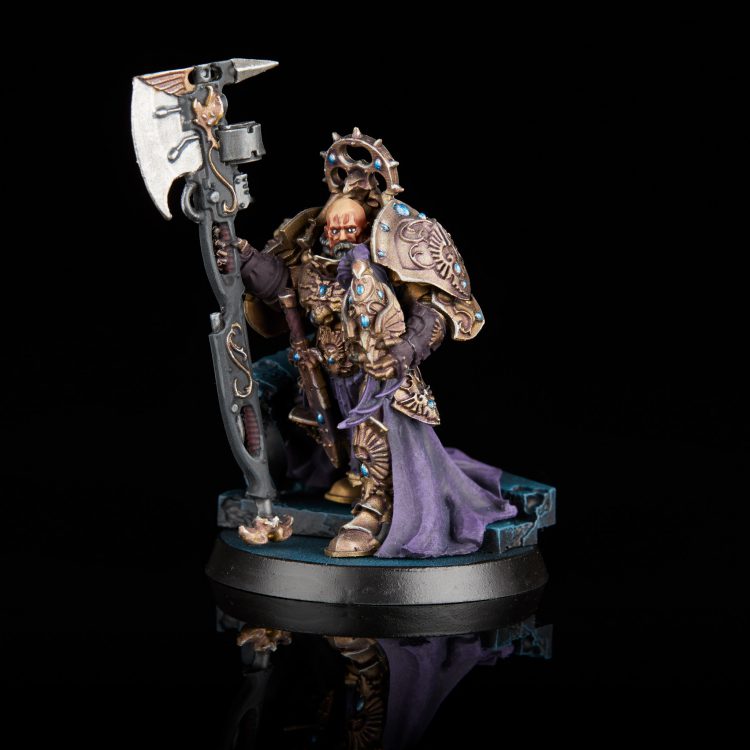
With two different fighting forces contained in the Codex, this book joins a few others in having two sets each of Warlord Traits and Relics, one for the Custodes themselves and one for Knight Centuras. The Sisters ones are a small but neat package with some interesting picks, while the Custodes get the broad range of options you’d expect.
Starting with the Custodes, there’s some extremely good stuff here. The first two are likely to be overwhelmingly seen on Trajann Valoris – if your army is pure Custodes he just gets to have two for free, which absolutely rules, but it does come at the cost of him having to be your Warlord, so these often won’t be available to others. Luckily these are both effects that you always want and are good on him – Master of Martial Strategy gives you 5+ CP regeneration when spending Command Points and the ability to re-order your Ka’tahs once per game just before you choose one, which can be nifty if you have a plan that wants you to burn through different Ka’tahs early on before returning to something from an earlier stance that you need in the late game. That ensures (alongside his aura) that you get incredible utility just from having Trajann on the table, but he’s also a killing machine – Champion of the Imperium gives him a 6” heroic and full hit re-rolls. Spicy stuff, and if you’re running him as Emperor’s Chosen it ensures you’ve got their re-roll left to use on his wounds, substantially increasing the chance of getting all his attacks through. Both of these are fine on other characters if you aren’t taking Trajann, but as we’ll cover in the datasheets section he’s a very strong option at a mere 170pts.
Next up, we have a returning favourite in Superior Creation – a straightforward 5+ to ignore wounds. Good clean fun, especially as all the Characters have had their baseline Wounds count boosted; if you’re a Custodes opponent who hated trying to kill 9-wound jetbike Captains before, you’ll be glad to know they’re all like that now. Impregnable Mind also returns but in significantly improved form – it still provides a Deny attempt with +1, but now also lets the model count as two additional models on objectives as well, and specifically stacks with other such abilities. For those playing along at home, a Custodes model with this trait counts as four guys for determining objective control, and keeping four models (especially ObSec) ones alive near a Custodes hero is a pretty steep task. We expect to see these two (or one of these plus a Shield Host trait) combined on a Allarus Captain with the Praetorian Plate and Unstoppable Destroyer a lot – it creates an incredible deathball of a model who can thwart your opponent’s Primary plans at a moment’s notice.
The last two are a bit less exciting, but still far from terrible, and if you have a third Custodes Character you can certainly add one of them – Radiant Mantle gives -1 to hit, while Peerless Warrior lets you inflict Mortals on 6s to wound, helping cleave down tough targets or hordes, and has the cute additional rider of not allowing the opponent to re-roll saves. That last one can be pretty spicy on a Blade Champion, as if they go with their sweep profile they can have a tonne of attacks, especially in Dacatarai.
For the Anathema Psykana three traits are available – but outside of themed lists going heavy on the Sisters, one stands out massively from the pack. Silent Judge gives the character a 3” aura that switches off enemy ObSec (and gives them Combat Attrition penalties, but that ain’t what you’re here for), and on a model that can be heading to battle alongside a bunch of ObSec Custodians that’s exceptionally strong. The only possible issue with it is that as we mentioned before, the Custodes ability to count as extra models for Look Out Sir only applies to Shield Host characters, so a Centura can be a little tough to keep safe if you’re heavy on MSUs (as this book encourages). It’s not the end of the world, though; if you keep her in a brick with shield Custodians or Dreadnoughts, or just bring a Pallas to escort her, she can be protected reasonably easily and adds some extra depth to your objective play. The other two traits, as mentioned, help out lists running more Sisters, allowing you to boost their Advances/Charges and their Range, plus letting them ignore cover. Not bad effects, but for competitive play we don’t expect to see many heavy Sisters forces.
Relics
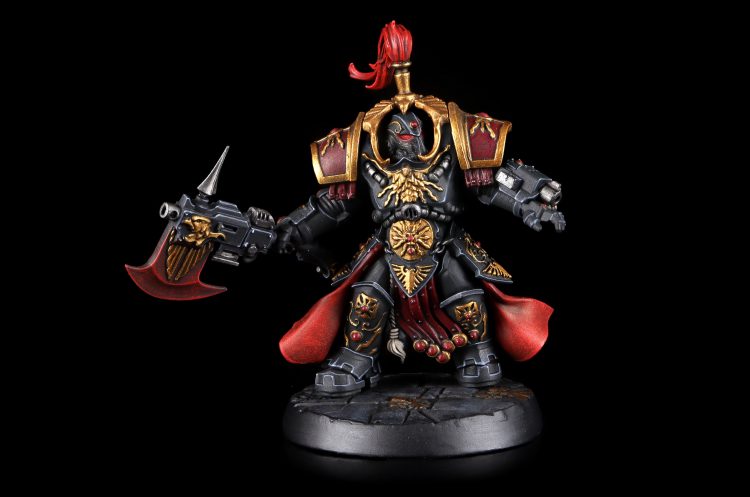
One relic rules them all here – the Praetorian Plate. It brings us no pleasure to announce that everyone who got mad at us every time we didn’t proclaim weird combos with the old version to be the best thing in Custodes now looks retroactively justified, because this thing is monstrous. It’s an upgrade to an Allarus captain that boosts their Toughness by 1, and allows them to do a teleporting Heroic-like effect once per game, as long as they’re not currently engaged. In the Heroic Interventions step of your opponent’s turn, you can just pick them up and place them anywhere that’s within 3” of a friendly non-VEHICLE unit, and that is also within Engagement Range of an enemy unit. There’s no requirement that the friendly unit be engaged, so as long as this model is alive and you haven’t blown the ability yet, there’s essentially a ~5” danger zone around all your units that this guy can attack stuff in (remembering that his base is 40mm, and he only has to be within 3” of the friend, not wholly within). Thanks to being ADEPTUS CUSTODES INFANTRY he’s ObSec, and you can also put Unstoppable Destroyer from the Captain-Commander section on him to make this even more powerful, as we’ll cover shortly. This is so good that we expect it to turn up in most lists that are running any serious numbers of Infantry and Bikers; it’s really only all-Dread lists that can’t use it.
The Plate is better than ever, but a few other popular choices from 8th have paid a bit of a price so that it could soar – notably the routes to 3+ invulnerable saves. The Auric Aquilas is a relic jetbike that lets you re-roll charges (or gives +1 if you already can), and gives you a super move, letting you double the model’s move characteristic at the cost of being able to shoot or charge. This can be situationally good, but now that Bikers aren’t ObSec there’s far more limited utility in moving one a long way if they can’t do anything when they arrive. The Eagle’s Eye does keep some of the old magic – it’s been limited to Infantry but does still give you one phase of a 3+ invulnerable save per game, and an extra wound at baseline. Good on a Blade Champion you’re planning to hurl at your opponent, and really what other kind of Blade Champion is there?
Next up, we have some upgraded weapons in Gatekeeper and the Veiled Blade. Gatekeeper massively amps up the shooting profile of a guardian spear, improving the number of shots, strength and AP, plus letting it auto-hit. This is potentially a decent choice on a Vexillus Praetor, as you can put him into Salvus with Martial Discretion and enjoy a cool eight auto-hitting shots, why not, a great way to squeeze some extra value from a buff unit. The Veiled Blade, meanwhile, adds extra attacks and AP to a sentinel blade, which is fine though we think it’s pretty rare you’ll want a sword/board captain. Rounding out your lethal methods of killing, the antimatter nightmare gun that is Obliteratum has returned, now sporting the much-coveted d3+3 damage. Like Gatekeeper, the most likely place to put this is on an Allarus Praetor, as it helps them contribute meaningfully to the fight, and it’s spicy as Emperor’s Chosen where you can reliably push a successful wound through with the re-rolls.
For more esoteric fare you have the Castellan’s Mark, providing the now-standard option to redeploy a couple of units or pull them into Strategic Reserves. If you’re planning on bringing some of the shootier Forge World units this can be worthwhile, especially if you’re expecting lighter tables, and you can use it to pivot how aggressively you’re deploying Praetors too. Finishing up for Custodes, you get a couple of fancy flags, one letting nearby CORE and CHARACTER units ignore Light and Heavy cover, and the other letting you call in a once-per-game delayed orbital strike. The ignore Cover one (the Fulminaris Aggressor) probably does have a place – it doesn’t replace the existing flag, so if you’re planning on stacking up a shooty firebase of Sagittarum and Venatari around a Vexilla Defensor then this can help ensure they grind the enemy down in good time.
Just like with Warlord Traits, Knights Centura get a trio of options here too – an upgraded Executioner Greatblade (sadly kind of meh) and then two pretty interesting options in the shape of a comically over the top super flamer and a defensive boost. The Excruciatus Flamer is extremely funny – it’s S6 AP-3 with a flat six shots, which can be enormously potent in some games. Those are “pick up most of an Incubi squad” numbers, and it’s utterly lethal on Overwatch. The Enhanced Voidsheen Cloak is potentially handy to throw on a Silent Judge because it provides the triple threat of -1 each to hit and wound, plus a 4+ invulnerable save. Centuras are pretty squishy and harder to protect with LoSir than Custodes characters, so this could turn out to be a valuable pick to give them a fighting chance in the case they get temporarily exposed. If that turns out not to be needed, then the flamer hits the sweet spot of being both very funny and pushed enough to be genuinely pretty good.
Realistically, the Praetorian Plate is an eye-popping standout for your free pick, with most of the others being situational depending on how you’re building your list, with the Eagle’s Eye probably taking second place as a “sure, why not” option.
Captain-Commanders
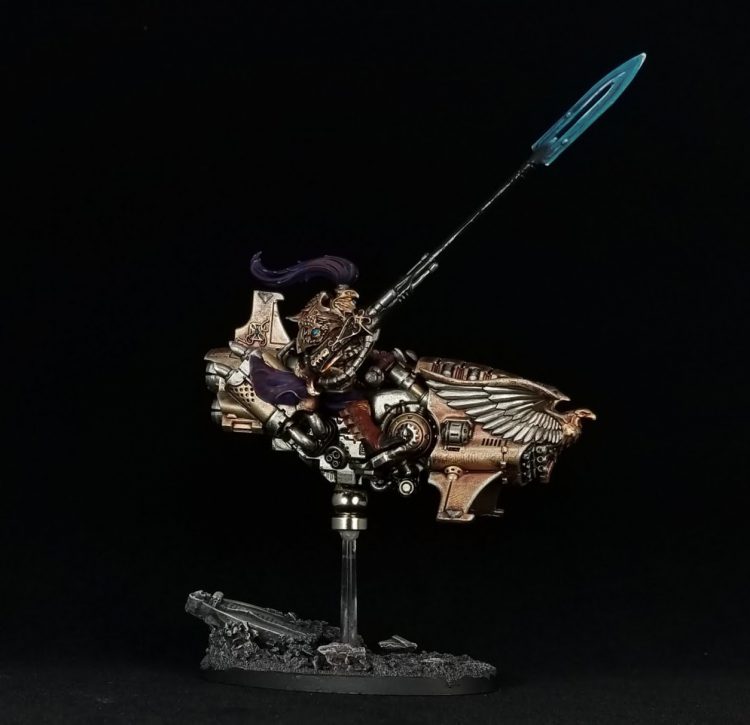
Upgrade time! Captain-Commander is the Adeptus Custodes option for spending some extra points to make an extra powerful killing machine. You can upgrade one Shield Captain using these rules in Combat Patrol or Incursion games, and two in Strike Force and larger, and you now have three sets of three options to pick from – one for each flavour of Shield Captain. The same rules apply to these as most such systems – only one per model, and you can only use each option once, you know the deal by now.
Starting with the basic captain, given the keyword GUARDIAN just so he doesn’t feel left out, we start with an intriguing utility option in Master of the Stances. This allows one nearby CORE or CHARACTER unit to benefit from both Stances of the current Ka’tah, and is probably most interesting if you’re trying to set up some combos with shooting units (though it isn’t cheap at 25pts). Much more interesting is Swift as the Eagle, letting the model Advance and Charge. This looks potent in the Solar Watch, as if you combine it with their Warlord trait you can have both a Captain and some buddies getting into battle quick. The final option just boosts the Captain’s re-roll aura’s size, and is unlikely to be worth it – you’re almost always going to have multiple auras to cover the table, and can create a new one in an emergency around any Dreadnought.
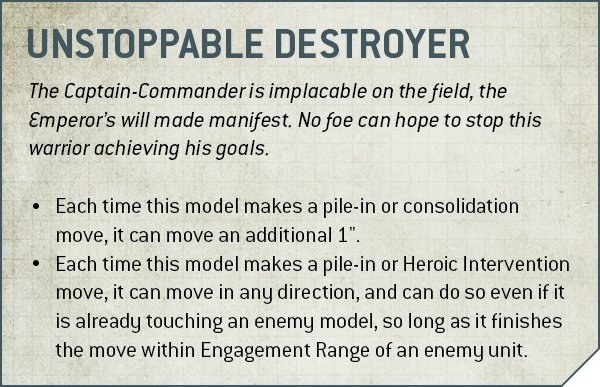
Moving on to Allarus Captains we have the big standout of this section, which is Unstoppable Destroyer. This increases the range of the model’s Pile-ins and Consolidations by 1”, and also adds a tonne of flexibility for movement. When piling in or performing a Heroic intervention, the model can move in any direction as long as it ends up in Engagement Range of an enemy unit, and can specifically do so even if already based (for pile ins). Outside of straight up wrapping the model, this makes planning for their combat movement hugely difficult, and means they’re always a threat to other high value targets near a melee they’re in (or just near them in general – don’t forget that the Fraternity of Heroes stratagem now allows a Character to do a 6” heroic). It gets even wilder with the Praetorian Plate – the bearer can teleport in to be in engagement range with one model, then stroll 4” past them to catch something else entirely by surprise (or to steal an objective with ObSec by circling to the back of the unit they’re touching). At only 10pts, this is a steal and you should take it a lot. The other two Allarus options aren’t bad (giving boosts to wound against key targets, or extra attacks as you lose wounds), but pale in comparison to the truly hilarious shenanigans that Destroyer lets you do.
Finally, the Vertus Shield Captain gets a set of tools that are ideal for their preferred role – zooming around the battlefield making a nuisance of themselves. Tip of the Spear gives them re-rolls of hits and wounds of 1 on the charge, which can be a lethal combo with Lockwarden to punk out opposing characters. For flexibility, Ceaseless Hunter allows them to fall back and charge, making them impossible to pin down, while Fierce Conqueror boosts their attacks by 2 if they’re within 2” of 6+ enemy models. Conqueror probably ends up as a miss – if you’re trying to take out horde chaff then the hit/wound re-rolls will do almost as much as +2A, and Tip of the Spear is way better if you’re acting as a Character assassin, which is what the bikes are ideal for. The fall back and charge from Ceaseless Hunter is good though, especially if you’re running Revered Companion to create a nigh-unkillable slab of a character, as it reduces the opponent’s options for dealing with them.
Secondary Objectives
Three secondaries to look at before we get to the datasheets and they’re kind of fine, if not outstanding. Some have clear situational uses – Might of Terra rewards you 4VP at the end of the Battle Round if at least one enemy unit has been destroyed and no friendly units have, and if you’re planning to bring an Ares along this is clearly for you – fly over, blow the enemy to bits, laugh as their weaponry glances off your 1CP Auspice. It suffers from sitting in the same category as Grind and generally being easier to mess with, at the tradeoff of only needing you to hit four turns to max it. Grind is likely to be better in non-flyer lists, but if you look at the opponent’s setup and think this is superior, go for it.
Following a trend of alternatives to common objectives we have Stand Vigil, a sort of alternative Stranglehold. This scores at the end of the Battle Round and gives you three points if you control more Objectives than the opponent which are not in either player’s deployment zone. This does kind of hit the same “why not just take Stranglehold” problem, especially because of the timing, and the best use case we can come up with is for five-objective missions, where it allows you to focus on hitting the centre and one flank without worrying about the other. However, in those missions it’s usually disastrously bad news if your opponent has managed to steal your home objective, and if you have your home objective then you’d be scoring Stranglehold almost any time you’d be scoring this. The other upside it plausibly has is that it does motivate the opponent to come and try and turf you off mid-field objectives in preference to trying to circle round to your home objective, which can force them into the kind of game you want to play. Not sure how well that theory plays out, but maybe!
The last one here is much more unique, and has been growing on us over time. Auric Mortalis (also our death metal band name) is a new version of the “assassinate a specific target” Secondaries seen in some of the Marine books, but works differently enough that it’s sometimes going to be significantly better. At the start of the game, you select one PRIMARCH or SUPREME COMMANDER in the enemy’s list, or if they don’t have one you pick their most expensive non-AIRCRAFT unit (selecting which if there’s a tie), and are tasked with killing it. If you destroy it at all it’s worth 5VP, if it was with a melee attack it’s another 5VP and if they were more than 6” from your deployment zone when they died in melee it’s a further 5VP – gotta hold the foe at bay. There’s one further catch too, and it’s very cool – for each of your units that get destroyed by the target before it goes down, you lose 2VP from the total you score for it.
That’s cool but it’s a lot of failure cases – so why is it growing on us? Simply put, this is sometimes going to throw a task at you that you’re flatly happy to just do. Drukhari Goodstuff lists are often going to have Drazhar or a Trueborn unit as the target, and the former is likely an easy 8 or 13 on this (he’s definitely dying in melee, and you probably have to price in him getting one kill first), while if you’ve got bikes then it can be really tough for them to avoid the latter – fly over, blow up the Raider with Salvo Launchers, charge, done. It also rules against current Ork lists – as long as they don’t have Ghaz, a unit of three buggies is probably their pick, and you should be able to take those down at some point. It can also be excellent against some of the current Knight lists that run one big one and lots of Armigers, as it gives you a very clear target you can chip down with shooting, then finish off at your leisure.
As with all such objectives the opponent gets some agency to play around it, but as long as you have the Bikes (I think you probably want two units minimum before picking this) you have scope to attempt it while retaining enough control. It feels like this is plausibly a pass lots of the time, but genuinely excellent if you find yourself facing the correct list for it, and an occasional spike of power from Purge the Enemy where the opponent might not otherwise be vulnerable in it is extremely handy. It also goes up in value if you’re running an assassination-focused Bike Captain in Shadowkeepers.
The Units
Mercifully for hard working content creators who have also had to do this section for Genestealer Cults, the Adeptus Custodes do not have that many units in the Codex itself – though the incorporation of the Sisters of Silence swells their ranks slightly. The sections below will cover just those datasheets that are actually in the book, though we’ll talk about Forge World afterwards since as mentioned above Custodes have a significantly bigger proportion of their usable and competitively relevant range in resin.
Also worth saying just as a general point – all Custodes now have Ld11.This is a far more interesting way to implement “these guys are fearless” than just flat-out ignoring morale. Most of the time your units will be mathematically unable to fail a Morale test, and rightly so, but your opponent can still utilise Leadership-modifying effects to try and force the issue. It’s nice design, effectively representing the Custodes’ superhuman bravery but in a way that doesn’t rob the other player of all their agency with Leadership effects, and we’re big fans. It also gives them some defence against the increasingly common “roll 3d6 against Ld” effects. Since the EV on 3d6 is 10.5, Custodes are far more resilient to these than almost any other army, and can also shrug off Incubi’s Tormentors unless the Drukhari player gets outrageously lucky – even the prospect of some nearby Grisly Trophies won’t faze the Custodians most of the time.
Also, all the melee profiles of the various Custodes gunblades are now flat D2. Fewer annoying dice rolls, but the current metagame is maybe not the perfect time to have received this given the dominance of Talos.
HQ
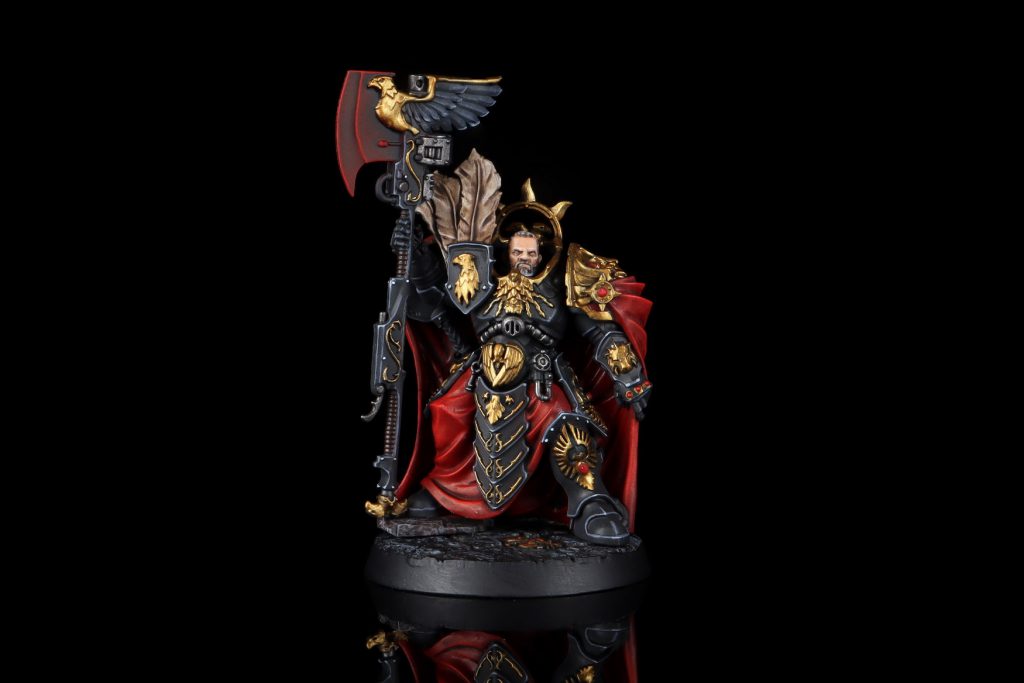
The HQ section provides you with three flavours of Shield Captain, Knight Centuras, the new Blade Champion and a trio of Named Characters.
It’s probably worth covering off the Named Characters first, because they start out with Trajann, who should be in nearly every Custodes list. At 170pts, you get an absolute monster bargain of a character – he’s a killing machine in melee (six attacks at S10 AP-3 D3), is very tough (4+ invulnerable, 8W, 5+ ignore wounds) and amps up all your CORE units nearby, providing re-roll 1s to hit and wound. He also gets a once-per-game additional flex with the Moment Shackle, letting him either interrupt combat for free, fight again at the end of combat, or just ignore the damage from a failed save – ideal if you find yourself needing to walk off getting hit by some sort of rail-based weaponry. Finally, he now gets the Shield Host tag, so shares your army’s Fighting Style (several of which rule on him – an Emperor’s Chosen Trajann is stupidly tough to kill), and if he’s your Warlord in a pure Custodes army he gets a second Warlord trait for free, and gives you a bonus CP. Pure, uncut value.
Less exciting on the named front but still OK are Valerian and Aleya, now two separate units, essentially acting as a representative of their non-Named character type with a relic weapon and an extra trick or two. Unfortunately, “Guardian Shield Captain” and “Knight Centura who can’t take Silent Judge” aren’t wildly useful niches from a strictly competitive standpoint, but both datasheets are fine – Valerian has perma-Transhuman, gets some extra re-rolls and prevents opponents using Ignore Wound effects, while Aleya is much crunchier in melee than a standard Centura, always Fights First, and gets to fight on death for free if she gets punked. Not written on her datasheet, but also relevant, is the fact that she acts as a Teleport Homer position for the stratagem. You can craft such nasty characters yourself that you just don’t really need these, but if you’re really into their Black Library appearances they look like they’ll be fun for narrative play.
Moving on to Shield Captains, the first thing to note is that these have had a glow up on baseline – they’ve all gone up to 6 attacks and have more wounds than in 8th Edition, and this is most noticeable on the Vertus Captain, who sports a mighty 9W before you even start upgrading him. The Vertus Captain also sees some weaponry tweaks that we’ll cover when we look at the bikes themselves, but the short version is that you pretty much always want a salvo launcher, and the lance now combos really well with Tip of the Spear. Realistically, when building lists you’re using these to assemble nonsense gods of war that fill specific niches or can pull specific tricks, and you’re thus most likely to see Praetorian Plate Allarus Captains as a first pick after Trajann, and/or (but most likely and) a Vertus captain just as an all-round killing machine, nuisance and assassin.
As an alternative for that third HQ slot, you have the Blade Champion, whose attractions are that he’s an extreme killing machine and he’s cheap. Being stuck with almost all their melee at flat D2 is a notable weakness for Custodes, and the Blade Champion being able to either take flat 3 swings with the Victus sword or make a bazillion smaller swings via Hurricanis, perhaps buffed with Slayers of Nightmares, adds some flexibility to your melee output. There are fewer wild combos you can set up with him than some of the other choices (though the Eagle’s Eye and the Peerless Warrior trait are both good here), but he gives you the most pure melee killing power for your points, which plausibly gets him into lists.
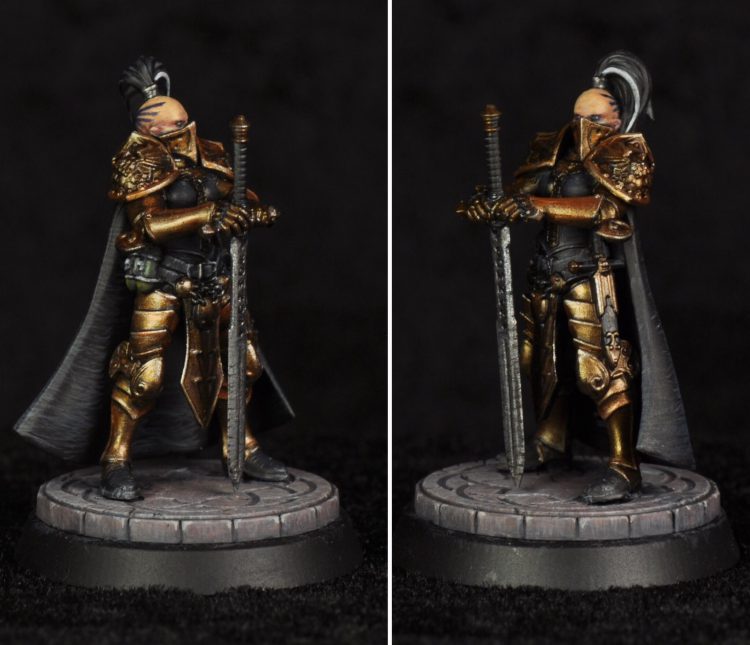
Finally, an alternative way to use a third HQ slot is with a Knight Centura, which you are likely doing for access to Silent Judge in competitive play. She also provides a useful re-roll 1s to wound aura for Sisters of Silence if you’re bringing lots of them, and can take any of their weapon types (getting an improved version of the bolter). For a bargain 50pts Judge is good enough that you’ll often be able to find room for her, and if you’ve contrived some sort of cunning plan involving Silent Sisters, the value goes up.
Troops
Two choices here – basic Custodians or Sisters of Silence Prosecutors.
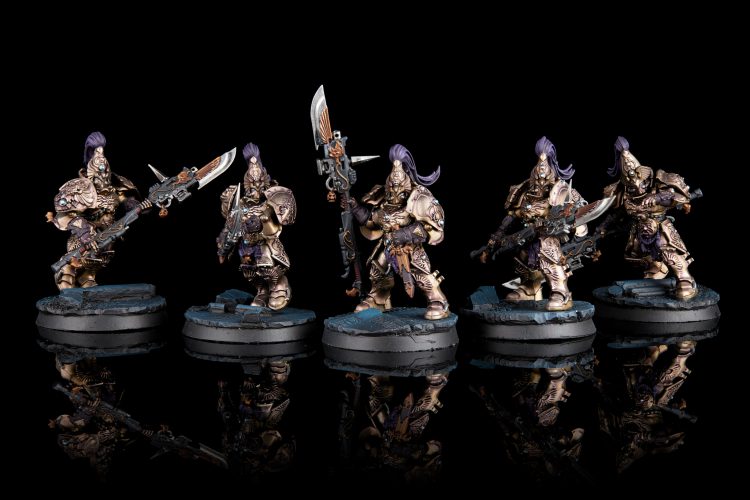
Your bog standard Custodian is just that bit more appealing on rate these days – the guardian spear has gone up to S7 in melee, helping them punch up into more things, and the sheer number of buffs your units can be under means they’ll get a bit more done. Realistically, units with praesidium shields (i.e. rebranded storm shields) are probably what’s going to get the nod in a lot of lists though. These improve armour saves by 1, though they no longer do anything for invulnerable saves, but it turns out that starting on a 1+ save with potential access to Cover in the open from a Vexillus Praetor still makes you tremendously hard to shift. Further sweetening the deal, the sentinel blade that comes with it has been given a tune up – while it’s shorter ranged than the spear, it’s just as lethal once you’re within 12”, and in melee it’s been pushed to S6. Taking all that together, shield custodians are still your number one choice if durable troops are your priority.
For the Sisters of Silence, Prosecutors are aggressively fine if you want to fill a Troops slot cheap – 60pts for some ObSec bodies you can leave on a home objective is absolutely going to be useful in some situations. That’s kind of all there is to say about them; they have the set of Anathema Psykana rules outlined above, and otherwise they’re power-armoured ladies with regular boltguns. If you’re filling a battalion with spicy toys and struggling to keep it all under 2,000pts, they can smooth over your list construction considerably.
Elites
The Elites slot brings some fancier Custodians and a few support choices. Custodian Wardens lead the charge – essentially your regular Custodes with an extra attack, a 6+ ignore wounds and the option to take castellan axes rather than the guardian spear, all coming in at a 5pt premium over the Troops. Unfortunately they can’t take the shield build, and probably get edged out by basic shield Custodians at the same price point. Like pretty much all infantry in this book, however, you can fundamentally expect to get more value out of a basic unit of three of these than in the old Codex, thanks to the weight of different buffs and options you can apply to them. They do at least have a Bodyguard effect for <SHIELD HOST> CHARACTERs, which can make those a little bit safer if they split off from the main pack.
Allarus Custodians provide some heavier hitters, and now have the unusual feature of coming in units of any size up to six, right down to a single model. They’re still chunky killers, can still split into a bunch of single-model units with Unleash the Lions, and are cheaper than they used to be at a mere 65pts (including the axe). The only knock against them is that the Auramite and Adamantium stratagem no longer exists, so they don’t particularly have any durability tricks not available to the rest of the list, but a squad of three to drop in then make a nuisance of themselves (potentially by splitting) seems plausibly useful. There’s also potential to take three of them as single-model units, giving you a bunch of deep strike-capable ObSec which can be irritating for an opponent to remove efficiently.

Next up – fancy flags. We took a look at these in our Shadow Throne review, and the big juicy draw here is that the Vexilla Defensor provides an aura of Light Cover in the open for CORE and CHARACTER units, incredibly good in an army that’s mostly 2+ base, and really helping soften the blow of praesidium shields no longer giving a 3+ invulnerable – with this in play, you’re still taking a 3+ against anything with AP-3 or less. The extra attacks from the Vexilla Imperius are also tempting, especially as they too apply to CHARACTERs, and we expect to see both these options tried (with the previously dominant Vexilla Magnifica moving to the back of the queue, as -1 to hit ain’t what it used to be, especially in a world where Dense terrain is seeing more play). Praetors come in both regular and Allarus flavours, and we suspect the basic version sees more use – now that these don’t apply to large vehicles there’s less impetus to plan to teleport one in, and the regular flavour getting an actual melee weapon means that they’ll contribute more (and are cheaper).
The last two units in this section probably see less use. The Venerable Contemptor Dreadnought is perfectly fine if given a multi-melta; mirroring its Forge World equivalents it’s down to 9 wounds and no longer degrades, and it picked up the standard Dreadnought ability of -1 incoming damage which it didn’t have before. While these are big wins for this big boy, you’ll still find the Achillus to be more deadly, and the Galatus to be more durable, which doesn’t leave a unique role for the Venerable Contemptor – but if you have one and put it on the table, it’s not going to disappoint you or anything.
Sisters Vigilators are the one unit here that both isn’t really filling a role that’s needed, and just isn’t very good. This army doesn’t need a glass cannon-ish melee unit – and even if it did, Vigilators don’t hit hard enough to do that super well.
Fast Attack
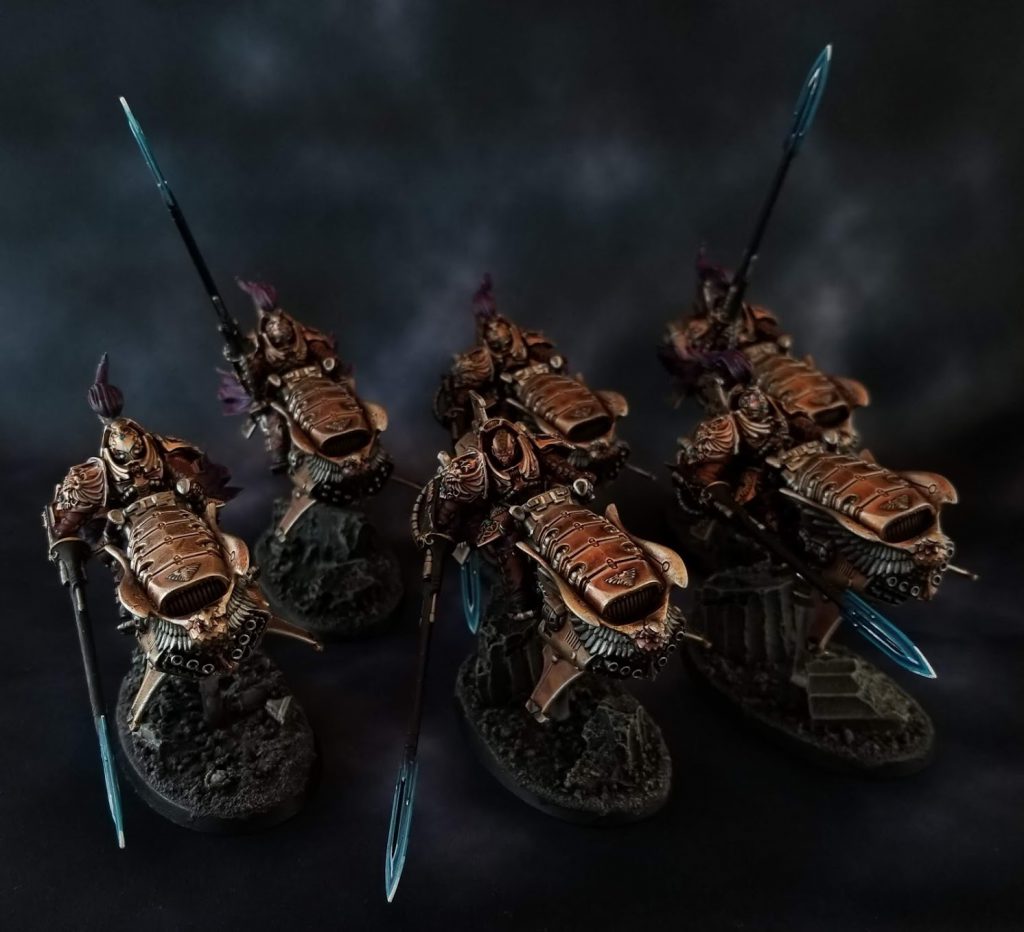
Vertus Praetors are, of course, the iconic Custodes Fast Attack unit, and while they’ve lost ObSec in the new book they’ve gained another key function – their salvo launchers are the faction’s source of d3+3 damage shots, and you absolutely want some, probably two units of three in a lot of lists. Further enticement is provided by a profile improvement – these now have a mighty five wounds each, significantly improving the unit’s ability to stand up to D2 firepower. Finally, their lances have been tweaked – they’re now +1 to wound on the charge rather than re-rolling wounds (a mild downgrade), but they also now strike at a base Strength 7, making this an overall upgrade when hunting targets with T6 or T7, and also combining better with the Emperor’s Chosen fighting style. Expect to see trios of these everywhere – apart from anything else, they’re also easily the biggest winners from the trend of variable cost stratagems, as popping Emperor’s Auspice on these for 1CP is hilarious value.
Joining Praetors in this slot are Sisters Witchseekers, who are at least somewhat interesting. These get a pre-game move like Dominions (which can be applied to a Transport they’re in), and have AP-1 on their flamers, both adding quite a bit of flexibility. It doesn’t seem outside the realms of possibility that a list wanting to just get a bit more stuff on the table could go with five of these, five Prosecutors and a Rhino to set them up in.
Heavy Support
Alas poor Venerable Land Raider, you are tragically cursed to bear the burden of being a Land Raider in 2022. Being fair to the unit, being able to pop Emperor’s Auspice on it for 1CP does elevate it substantially above the utility of many other Land Raiders, but sharing a rough price point with a salvo launcher Praetor squad and the Telemon is just terminal for it. Like a lot of the stuff in the book that gets edged out, using one probably will feel better than it used to, especially as Emperor’s Chosen where it can make strong use of the re-rolls, and the quality of what it can deliver to battle is way higher than in other codexes. Given what else you could take for the points, though, you’ll have to really want to honour the name of Arkhan Land, and not by blowing things up with missile-toting jetbikes.
Dedicated Transport
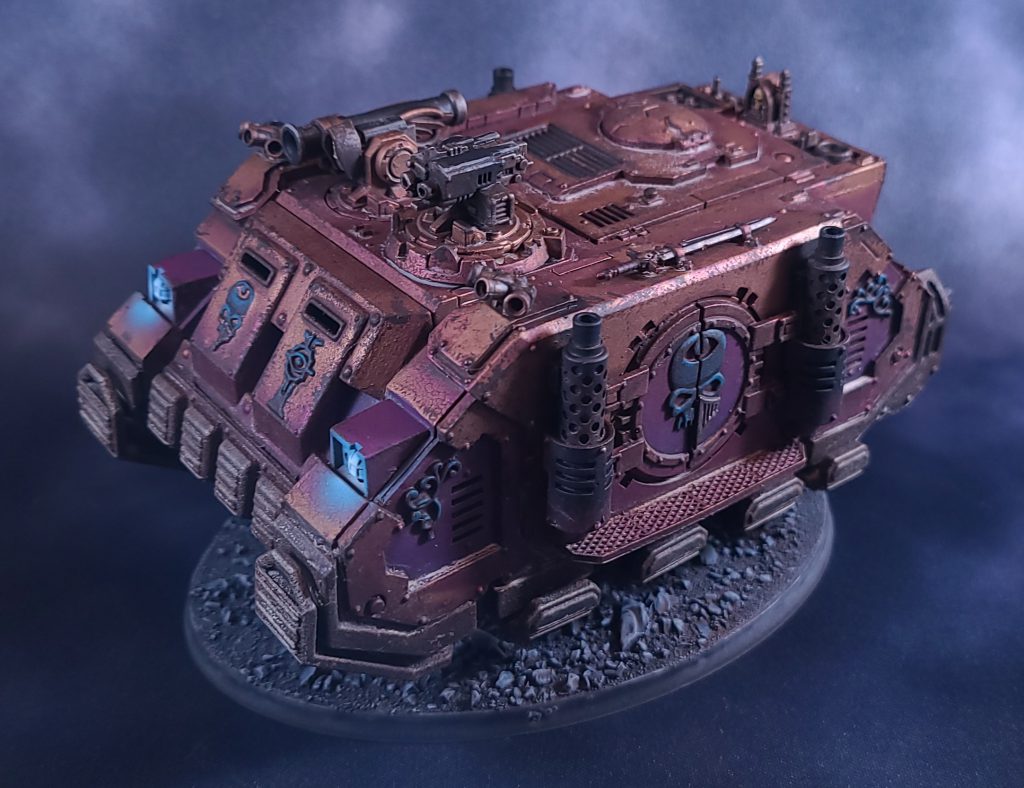
The Null Maiden Rhino carries Sisters of Silence around, and it’s a cheap hull that can help with the new version of Engage. That means you will sometimes want one, and it’s particularly good if you have a Witchseeker unit to help it get into useful positions.
What About Forge World?
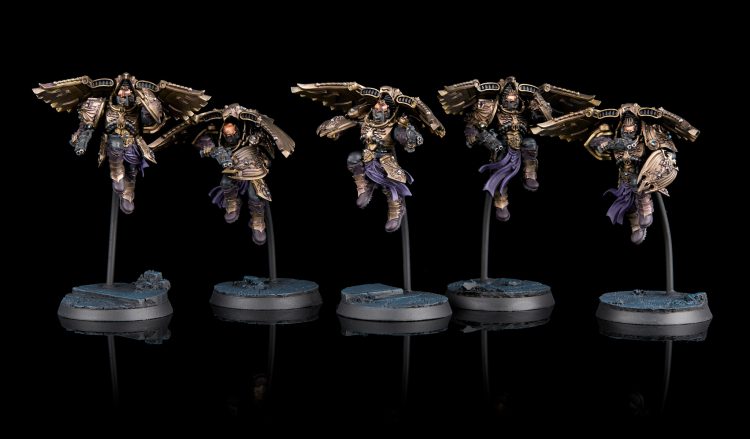
We’re not going to re-review the full breadth of Forge World stuff here, but the basic and unsurprising summary is that Saggitarum and Venatari Custodians plus Achillus and Galatus Dreadnoughts work outstandingly well with plenty of what’s been added in this book, and will continue to be list staples. The Pallas probably also gets a bit more airtime in Emperor’s Chosen lists, and the hefty vehicles plus the Telemon are likely to have workable builds that use them, especially as the giant Dreadnought doesn’t care that much about not being CORE in Chosen lists. Losers are likely the Aquilon Terminators and Agamatus bikes – with regular Infantry just a bit better all-round it’s hard to justify the price points on the former, while the Agamatus are flatly outclassed by Vertus Praetors now. The only thing giving us pause on the Aquilons is that the army in general can struggle a bit with Damage Reduction, so the solarite power talon might be pretty good, especially as you can enter Dacatarai with it at no downside.
Overall, our rough priority order for FW toys would be:
- Venatari – nothing else does quite what they do, especially now the Bikes don’t get ObSec.
- An Achillus Dread – the huge melee swings give you a far more direct route around Damage Reduction, and having one around to put Wisdom of the Moritoi on is good.
- Saggitarum
- Galatus Dreads
- Everything else.
Our Thoughts
How They’ll Play
Custodes have one main plan, and it’s one they perform very effectively – march towards the enemy, seize objectives, kill anyone who stands in their way. Custodes usually want to strike for the mid-table in force, leaning on their defences and powerful melee capabilities to take control of some objectives, then holding onto them in the face of pretty much anything. While that’s going on, their more mobile or independent elements like Vertus Praetors, Venatari and Dreadnoughts can be causing mayhem on a flank, either pushing aside weaker forces or soaking up enough of the opponent’s assets that the main wedge goes unchallenged.
All throughout this you need to be keeping an eye out for any sign of weakness in the opponent’s position, and if you spot one it’s often worth swinging for it – pushing Custodes off a position they’ve taken is a huge challenge, and at the point where the opponent is scrabbling to redeploy their forces to regain a foothold, the game is usually over. Knowing when to stick to a solid defence and when to go for the throat is a key skill to master with the Custodians, as while they’re capable of taking over the table, their numbers are few and losing a few units to being over eager can be backbreaking. As long as you build a real understanding of what your units are capable of and how to get the most out of each of them, many glorious victories await.
Hot Takes
Liam “Corrode” Royle
The Custodes codex seems like a pleasant surprise – a book that threads the needle of taking the previous iteration and reining in some really tiresome effects, while retaining and improving some of the useful flavour and power and adding some new bits of its own. Throughout 9th edition the Adeptus Custodes have sat in a middle-to-high tier 2 place in the meta, capable of going the distance and winning events but without the easy power that gives a faction a lock on the top placings (looking at you, Drukhari). That’s a good place for a book to be, and there was a lot of concern in the run-up to this Codex that it would swing Custodes too far in one direction or another – would GW overreact and strip away what made them work before, or would they “fix” units by turning all the knobs at once and creating a monster?
It looks like the answer is “neither”, and instead this feels like a well-considered book which adds some new depth to the faction, keeping it in the conversation for upper-mid tier power without overcooking it in a way that makes an opponent sigh when they see the golden boys across the table from them. If you read much online Warhammer discussion (and if you don’t, how have you come to be reading this review?) you might have noticed that a faction’s players often react poorly to a new Codex on first read, because many of them seem to believe that the optimal design for a new book is to change nothing about the army they’re already playing while also giving them new and better stuff. Whatever you think of that mindset, my opinion is that this book does a better job than others of striking a balance between refreshing the army without invalidating what came before.There’s good reasons to look at previously-unloved units with fresh eyes without also picking up the ones that were strong before and throwing them directly into the bin. As someone with a fledgling Custodes army in the works, it’s an exciting time.
Pendulin
Remember back in the day when Toughness 5 meant that something was hard to kill? Back when Damage 2 weapons would instill fear? The Adeptus Custodes codex remembers, and is a flashback to those simpler times.
This is a codex that many, including myself, will have a lot of fun playing. There are some exceptionally cool combinations you can build with different Shield Hosts, Warlord Traits, Relics, Captain-Commander upgrades. On top of that, you can pull some unexpected tricks with the Sisters of Silence half, like turning off ObSec via Silent Judge. But despite that, I fear this codex will have an exceptionally tough time going up against the heavy hitters in the current meta. With -1 incoming damage being so prevalent, a codex based around D2 weapons is going to have a rough time. With the game being deadlier than ever, a 2+ save doesn’t mean as much as it once did, and a highly-elite army is going to feel the impact of each model getting removed from the board.
Are there builds that will see some competitive success? Sure. Trajann Valoris is as unkillable and deadly as ever, and the Blade Champion is an absolute powerhouse. Vertus Preaetors will continue zipping around the battlefield and being absolute bullies, and Venetari gaining ObSec makes them great at stealing objectives with their 12” flying move. There are some combinations that will see plenty of success, especially while your opponents are getting used to the new golden boys.
But there’s something about this codex that doesn’t feel like it matches its own narrative. For example when you fight against Death Guard, you feel the grind as they slowly approach, your weapons doing little but leaving pocks on already-marred flesh. When you fight against Drukhari, they are everywhere right when they need to be, unleashing a whirlwind of death, and are gone again in the blink of an eye. When you fight against Adeptus Mechanicus, your opponent is still in their command phase after thirty minutes and, come on man, just pick a Canticle, there are only six.
This codex feels like it’s lacking something I can point to and say “Yeah, that’s Custodes right there, that’s what this army is all about.” Maybe they have it and I’m just looking past it: army-wide ObSec on infantry is pretty remarkable, 2+ characteristics across the board is signature Custodes, and the characters in this book can single-handedly shape a battle. Maybe it’s one of those, or maybe it’s any of the other abilities this book is stuffed with. But on the other hand, maybe it’s not and Custodes are just an army of extra heavy Intercessors.
My hot take in summary: there is a lot of fun to be had in this codex, but I wish the meta wasn’t in a state where I look at these Toughness 5 models with 2+ characteristics and say “Okay, but what makes them unique?”
Wings
I like this book – not as much as I love the Genestealer Cults one, but it’s another quality entry into the 9th Edition canon, and looks like it should be fun to play with. Custodes are another army that aren’t trivial to write rules for, as making an elite force really work in army-scale confrontations without making any individual unit overwhelmingly powerful is tough to get right, and I think this book does a good job of it. Some of the most extreme tricks are gone (e.g. Stooping Dive, whole unit 3+ invulnerable saves) but the power budget that opens up has been shared around pretty broadly, helping every unit feel like it’s pulling its weight on the table, and vastly reducing the number of situations where it will be safe to just ignore the Custodes – between deadlier melee output and double counting on objectives, getting into a fight with the golden boys is always bad news.
What seems to be really key to making it work is the variable cost Stratagems, and I think if you’re an existing Custodes player looking at this and feeling faintly disappointed, definitely play a few games to get a feel for just how transformative 1CP Arcane Genetic Alchemy and Emperor’s Auspice are – it’s big stuff. I also feel like Ka’tahs are one of the more impactful versions of the “changing ability over the game” effect that GW have written, and the rewards if you choose to go for an Infantry/Biker heavy list are considerable. On the flip side, I do also like that the Forge World units that have been powering the faction until now all still look fine – no one’s army is getting thrown in the bin here, and that’s always good.
I do have a few critique, mind, mostly that I think Trajann and the Emperor’s Chosen are both a little bit over-pushed compared to other options. Trajann is such a spectacular bargain for his cost that it’s very difficult to see why you’d ever leave him out, while the Chosen’s fighting Style honestly just feels like it’s going to chase some of the other (very interesting) Shield Hosts out of contention. Neither of these are deal breakers, but I think in both cases the power could have been a little lower while still remaining an extremely respectable choice and opening space up for others. On the other side of things, I do think it would be nice for Custodes to at least have access to the ability to sometimes ignore damage reduction in melee, maybe as one of the Ka’tah stances, but I’m guessing that it wasn’t nearly as prevalent in the metagame when this was written (and there’s always future supplements).
With those minor complaints out of the way, I still think this book is a success overall, and as a double header with Genestealer Cults gives us a very strong start to the 40K year. Very excited to see what the metagame makes of this one.
Army Lists
Liam “Corrode” Royle

Emperor’s Chosen Battalion – 9CP
-2CP, The Emperor’s Heroes
-1CP, Victor of the Blood Games
-1CP, Eternal Penitent
+1CP, Trajann
HQ – 360
Trajann Valoris – 170, Warlord, Champion of the Imperium, Master of Martial Strategy
Allarus Shield-Captain, spear – 135, Captain Commander (Unstoppable Destroyer), Relic: Praetorian Plate, WLT: Superior Creation, Impregnable Mind
Knight-Centura, executioner greatblade – 55, WLT: Silent Judge
Troops – 450
3 Custodian Guard with sentinel blades and praesidium shields – 150
3 Custodian Guard with sentinel blades and praesidium shields – 150
3 Custodian Guard with sentinel blades and praesidium shields – 150
Elites – 350
Contemptor-Galatus Dreadnought – 170
Contemptor-Achillus Dreadnought, twin adrathic destructor – 180, Eternal Penitent
Fast Attack – 830
5 Venatari Custodians, kinetic destroyer and tarsus buckler, misericordias – 290
3 Vertus Praetors, salvo launchers – 270
3 Vertus Praetors, salvo launchers – 270
Points: 1,990
This is what I ran in a test game, just trying out some of what the Codex had to offer. It’s surely far from an optimal build, but it felt great fun on the table. The basic idea is to anchor the list around a block of shield Guard, supported by Trajann and the Knight-Centura, while the Dreadnoughts, Venatari, and Vertus Praetors offer punch against a wide range of targets. The jetbikes are great all-rounders, being both tough to kill (especially with the defensive Stratagems they can utilise for a mere 1CP), deadly at range, and capable of blasting off and into melee if needed. James was highly annoyed to throw a big round of Genestealer Cults shooting into three of them and only just kill one, leaving them free to zip around and fire salvo launchers at things before attempting to assassinate his Patriarch in melee – only being stopped by a fistful of timely invulnerable saves. Even after the swing back one remained, ready to jump into the backfield and pop off another missile at a character with the fall back and shoot Stratagem.
Being able to stack up Warlord traits on the Allarus Captain was great fun, too. Between his 8 wounds, his 2+/4+ saves, and being able to ignore wounds on a 5+ (or a 4+ against mortals), he held down a flank pretty much by himself, while forcing James to commit real numbers to stop him stealing an objective solo. With the Praetorian Plate and Unstoppable Destroyer, he’s a danger that your opponent must keep in mind, with the flexibility to pull off unexpected movement trickery that feels like it’s a preview of the Craftworlds book to come.
Wings
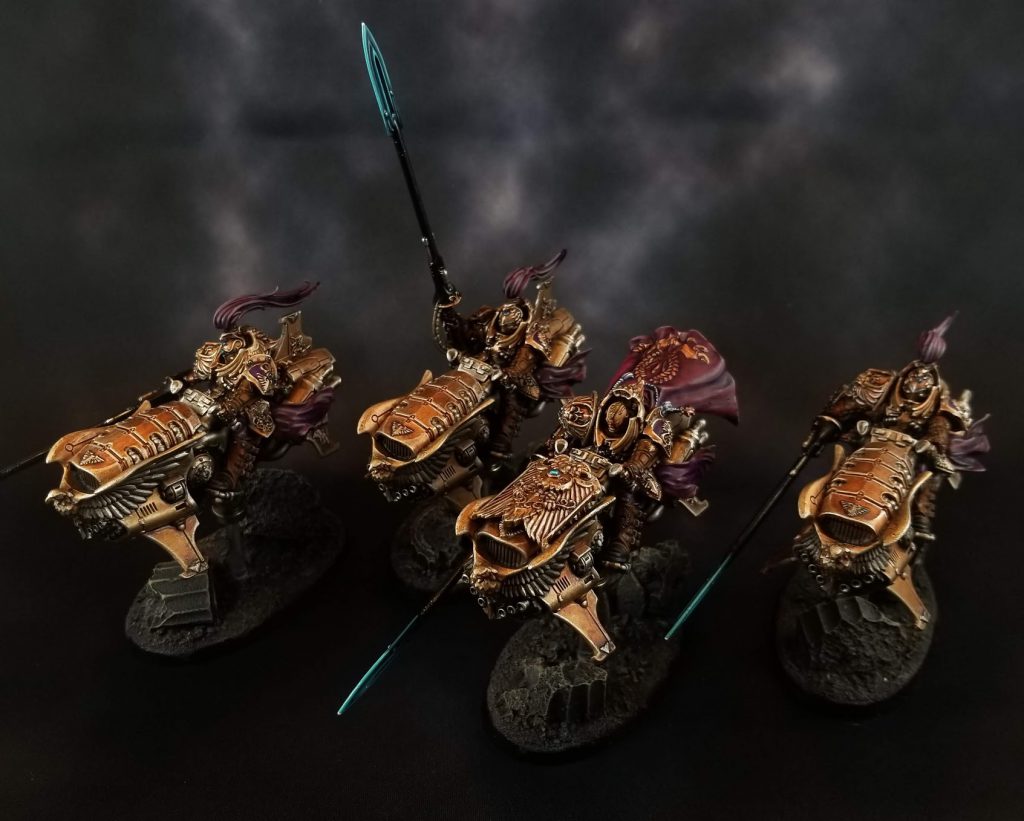
Naturally if left entirely to my own devices I would also be fielding an Emperor’s Chosen list, but there genuinely are plenty of other things you can do with the book, and the following has its charms as well. I was also thrown the challenge by Corrode of writing a list with no Forge World units – which this general plan adapted to pretty well.
Shadowkeepers Battalion – 8CP
-2CP, The Emperor’s Heroes
-1CP, Victor of the Blood Games
-2CP, Open the Vaults
+1CP, Trajann
HQ – 470
Trajann Valoris, Warlord, Champion of the Imperium, Master of Martial Strategy – 170
Vertus Shield Captain, Superior Creation, Lockwarden, Stasis Oubliette, Tip of the Spear, Salvo Launcher – 190
Blade Champion, Peerless Warrior, The Eagle’s Eye -110
Troops – 480
3 Custodian Guard with sentinel blades and praesidium shields – 150
3 Custodian Guard with sentinel blades and praesidium shields – 150
4 Custodian guard with guardian spears – 180
Elites – 238
Allarus Custodian, misericordia – 68
Allarus Custodian, misericordia – 65
Vexillus Praetor, Vexilla Defensor, Castellan’s Mark- 105
Fast Attack – 810
3x Vertus Praetors, salvo launchers – 270
3x Vertus Praetors, salvo launchers – 270
3x Vertus Praetors, salvo launchers – 270
Points: 1998
Shadowkeepers reward you for running lots of bikes, as they add an additional defensive stratagem to your arsenal in Grim Responsibility and tank the capabilities of everything they slam into thanks to the first part of their Fighting Style. This list goes for the full 3×3 plus a Vexilla Defensor to keep them as durable as possible against any early onslaughts. WIth the Castellan’s Mark, you can also afford to be extremely aggressive with how you deploy some of them, or at the very least can make sure they’re in strike range of key targets out of the gate.
That obviously eats a big chunk of points, but still leaves plenty for a solid core – a couple of shieldguard units and a slightly bigger guardian spear squad to anchor the line and provide a bit of threat. The spear squad opens up the option of using Martial Discretion for a decently sized volley of D2 shots via Salvus in an emergency.
Rounding things out, we have a nightmare Bike Captain, fully loaded for Character hunting and general backfield menace, plus two singleton Allarus. These guys are the final big winners from the -1A trait – they can already tangle with a lot of other utility units and come out on top, but add in what will often be a 50% reduction in the attacks that are coming at them and they’re a nightmare to shift.
Honestly, I think this list looks extremely scary – many armies are going to struggle to extract themselves once the bikes hit, and they’re on a very short clock to do something about that.
Wrap Up
…and that’s it for our second book for today. Now the waiting begins as cogs start turning in the brains of players worldwide, trying to work out the most cunning ways to put these new tools to use, and we can’t wait. Comments, questions and suggestions to contact@goonhammer.com.
